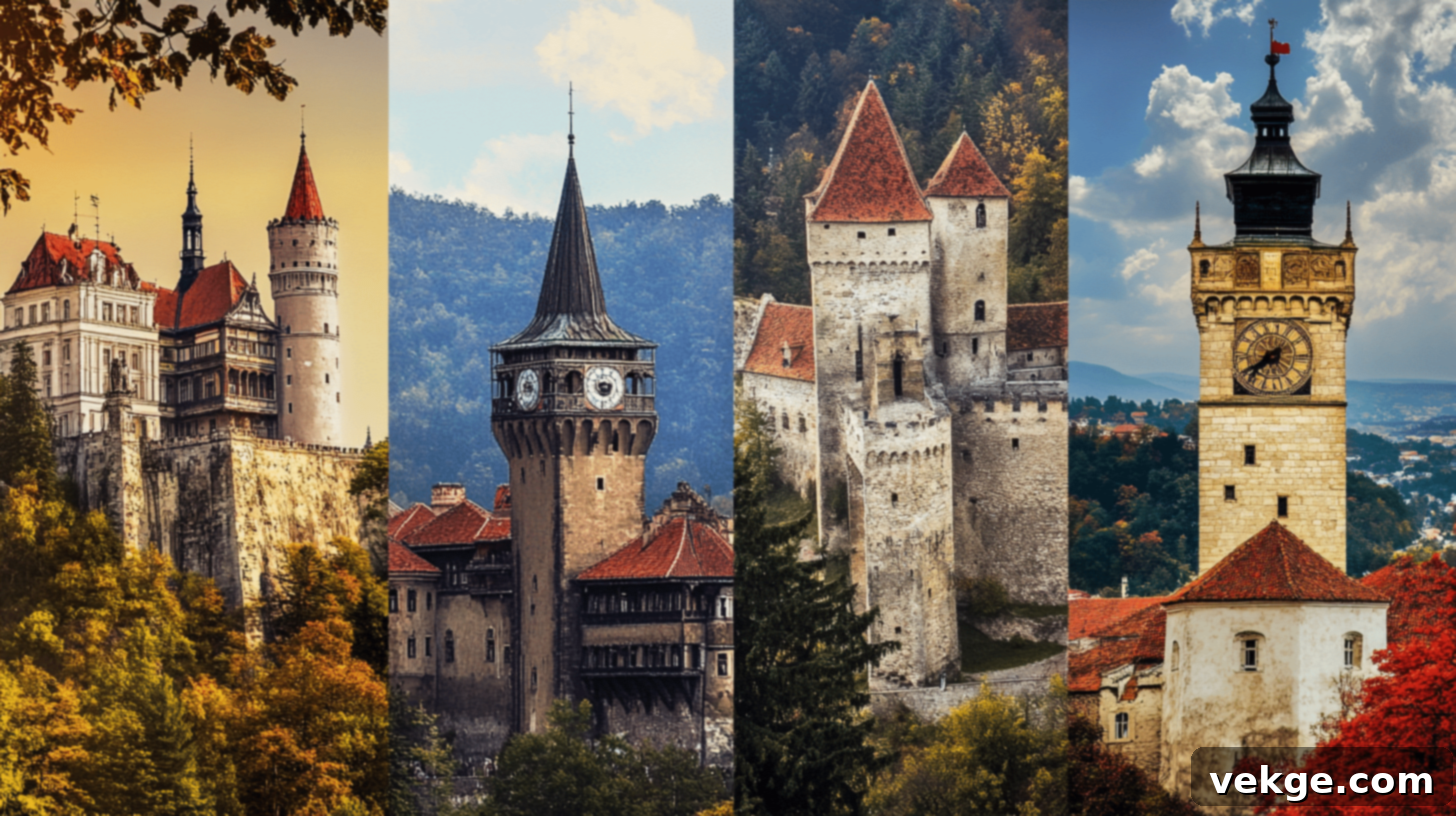Discover Romania’s Most Enchanting Landmarks: A Comprehensive Travel Guide
Are you looking for an unforgettable travel experience, eager to explore new destinations and create lasting memories? Look no further than Romania, a captivating Eastern European country that promises a journey through centuries of rich history, vibrant culture, and breathtaking natural beauty. Often overlooked, Romania is a hidden gem waiting to be discovered, offering a diverse array of sights that tell compelling stories of its glorious past and unique heritage.
From the mystical allure of ancient castles nestled in the Carpathian Mountains to the serene charm of picturesque villages, Romania beckons visitors with its distinct character. This land where history and natural splendor converge in remarkable ways provides an unparalleled opportunity to delve into a truly authentic European experience. Prepare to be enchanted by its majestic landscapes, fascinating legends, and architectural marvels.
Our meticulously curated guide to Romania’s most important landmarks is designed to help you navigate this incredible country, ensuring you see the absolute best it has to offer. We’ll take you on a journey through both world-renowned attractions and hidden treasures that many travelers have yet to uncover, revealing the true essence of Romania.
Explore the Majestic and Must-Visit Landmarks of Romania
1. Bran Castle (Dracula’s Castle)
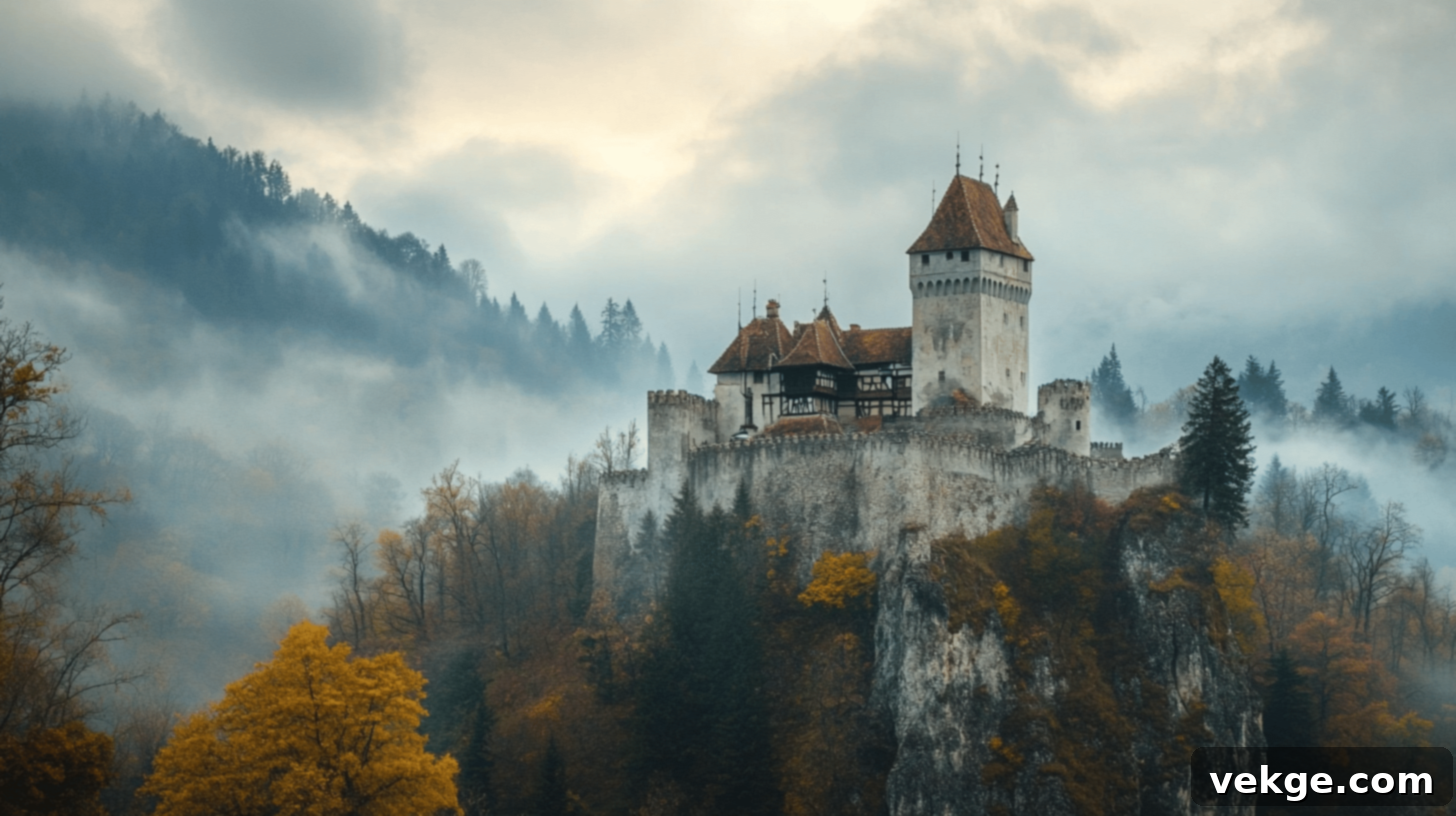
History and Importance: Standing proudly as a symbol of Transylvania, Bran Castle is a medieval fortress steeped in history and famously linked to the legends of Vlad the Impaler, the inspiration for Bram Stoker’s Dracula. Constructed in 1377, the castle played a crucial strategic role, serving both as a military defense point against the Ottoman Empire and a customs post between Wallachia and Transylvania. While direct historical ties to Vlad the Impaler are tenuous, its dramatic Gothic architecture and mystical ambiance have cemented its place as a global icon of Romanian cultural heritage, drawing millions of tourists fascinated by its dark romanticism and compelling storytelling.
When to Visit: The ideal times to visit are during late spring (May-June) or early autumn (September-October) when the weather is pleasantly mild, and the surrounding scenery is at its most beautiful. Summer months, while popular, can be significantly more crowded with international tourists, leading to longer queues.
Fun Facts:
- Queen Marie of Romania, a beloved figure, extensively restored and beautified the castle in the early 20th century, making it her favorite residence.
- The castle boasts a labyrinthine layout with 57 interconnected rooms, each revealing a piece of its storied past.
- Within its walls, visitors can discover a remarkable collection of unique historical artifacts, including period furniture, armor, and artwork, offering a glimpse into medieval aristocratic life.
2. Palace of the Parliament

History and Importance: Dominating the Bucharest skyline, the Palace of the Parliament is an awe-inspiring, yet controversial, symbol of Romania’s communist era. Initiated under the regime of Nicolae Ceaușescu and completed in 1994, this colossal structure stands as the world’s largest civilian building and the second-largest administrative building globally. Its construction demanded immense national resources, including the demolition of a significant portion of Bucharest’s historic center, making it a powerful and enduring architectural statement that reflects the complex political landscape of Romania during its communist period. Today, it houses the Romanian Parliament, an international conference center, and several museums.
When to Visit: To avoid the extremes of summer heat or winter cold, it’s best to visit during spring (April-May) or autumn (September-October). During these seasons, temperatures are moderate, making exploration more comfortable, and tourist crowds are generally smaller.
Fun Facts:
- This gargantuan building weighs approximately 4,098,500 tons, a testament to its sheer scale and the materials used in its construction.
- It contains an astonishing 1,100 rooms spread across 365,000 square meters, making it incredibly intricate and vast.
- The Palace utilized massive quantities of luxurious Romanian materials, including over 1 million cubic meters of marble, 3,500 tons of crystal for chandeliers, and 700,000 tons of steel and bronze.
3. Peleș Castle
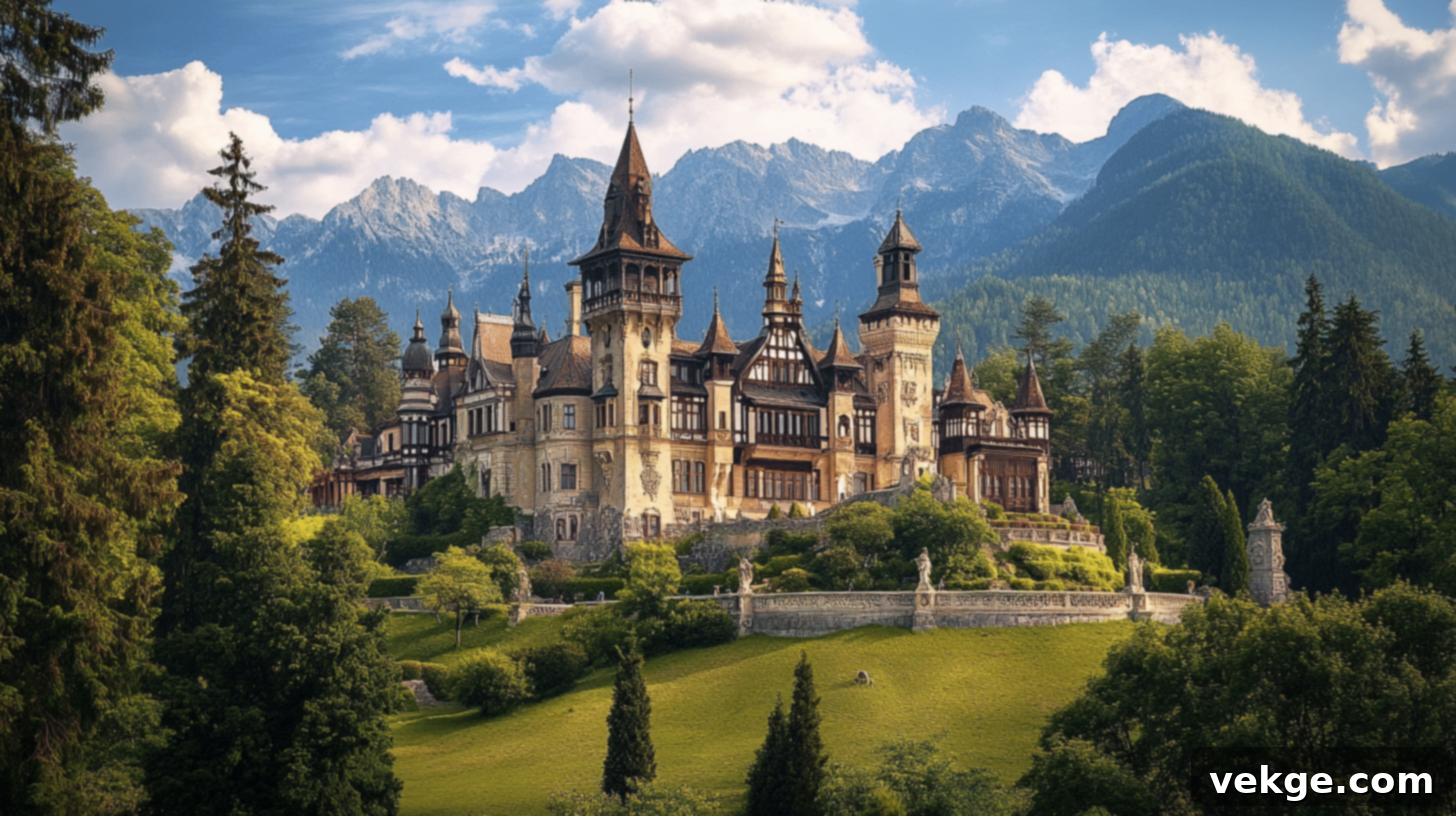
History and Importance: Nestled amidst the picturesque Carpathian Mountains near Sinaia, Peleș Castle is a magnificent masterpiece of Neo-Renaissance architecture that served as the cherished summer residence for the Romanian royal family. Commissioned by King Carol I, its construction spanned from 1873 to 1914, blending German, Italian, and Romanian architectural elements. The castle is not merely a residence but a significant cultural and historical landmark, representing a golden age of Romania’s monarchy and its aspirations for modernization and European integration. Its exquisite artistry and technological innovations (for its time) make it one of Europe’s most beautiful palaces.
When to Visit: Late spring and early autumn offer the most optimal visiting conditions. The mild temperatures are perfect for exploring the castle’s interiors and the surrounding grounds, which are vibrant with lush greenery in spring or stunning autumnal colors.
Fun Facts:
- Peleș Castle was the first castle in the world to be completely powered by locally produced hydroelectricity, a marvel of engineering for its time.
- It boasts over 170 elaborately decorated rooms, each filled with exceptional artworks, antique furniture, and historical artifacts.
- Each room within the castle often represents a different historical or cultural theme, showcasing diverse influences from across Europe and the Middle East.
4. Corvin Castle (Hunedoara Castle)

History and Importance: Corvin Castle, also known as Hunedoara Castle, is an imposing Gothic-style fortress constructed in the 15th century and represents a crucial piece of Transylvanian medieval architecture. Built on the foundations of an earlier fortification by the illustrious Hunyadi family, it served as the magnificent residence of Matei Corvin, one of Hungary’s most influential kings. This formidable castle, with its drawbridges, inner courtyards, and numerous towers, vividly symbolizes the region’s complex historical transformations and the military prowess of its former rulers. Its dramatic appearance and rich history make it a truly captivating destination.
When to Visit: Late spring and early autumn are the best times to experience Corvin Castle. The favorable weather conditions are perfect for exploring both its expansive outdoor fortifications and its intricate interior spaces without the discomfort of extreme heat or cold.
Fun Facts:
- The castle is associated with a famous legend about a deep well dug by three Turkish prisoners, who were promised freedom if they found water. After 15 years, they found water, but their captors did not keep their promise.
- It features a fascinating blend of architectural styles, primarily Gothic and Renaissance, with later Baroque additions from subsequent restorations.
- Corvin Castle has undergone extensive restoration efforts over the centuries to preserve its historical integrity and breathtaking medieval grandeur, making it one of the best-preserved castles in Europe.
5. Romanian Atheneum (Ateneul Român)

History and Importance: The Romanian Atheneum, or Ateneul Român, is an iconic concert hall in Bucharest that stands as a vital cultural institution and an architectural gem. Completed in 1888, its construction was largely funded through public donations raised via a “Give a Leu for the Ateneu!” campaign, making it a true symbol of national pride and cultural aspiration. The building beautifully embodies Romania’s artistic ambitions during the late 19th century, serving as the primary venue for significant musical and cultural events, and housing the George Enescu Philharmonic Orchestra. Its elegant design and rich acoustic environment continue to inspire.
When to Visit: To fully appreciate its purpose, it is highly recommended to visit during concert seasons, typically in spring and autumn. This allows visitors to experience the Atheneum as a vibrant cultural hub, witnessing its magnificent acoustics and grand atmosphere during a performance.
Fun Facts:
- The breathtaking circular hall features a massive 75-meter-long fresco that vividly depicts the most important moments of Romanian history, offering a visual journey through the nation’s past.
- It was designed by the French architect Albert Galleron, who also contributed to the design of the National Bank of Romania.
- The Romanian Atheneum is widely considered an architectural masterpiece of Bucharest and is a listed historical monument of national importance.
6. Sighișoara Clock Tower
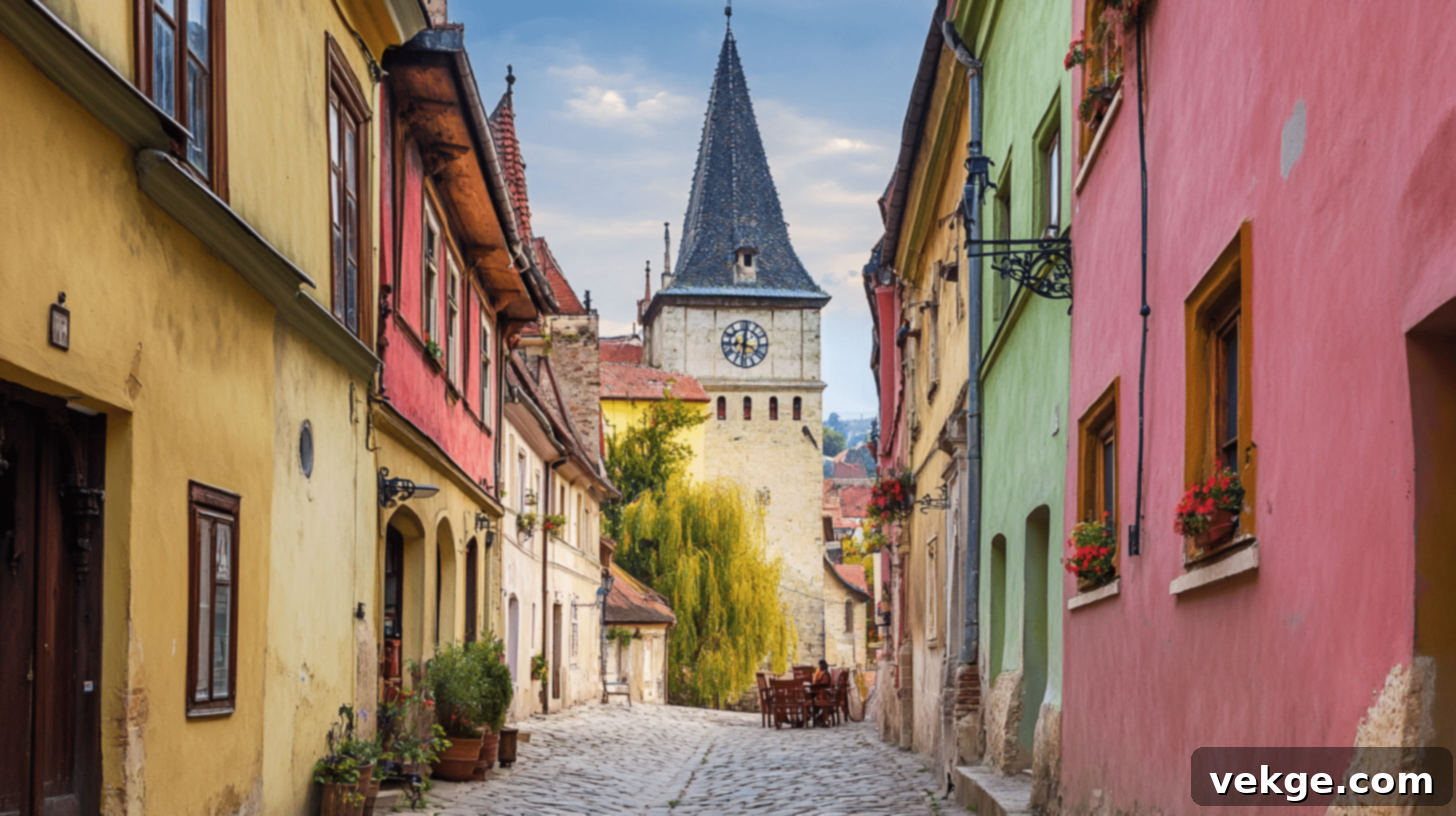
History and Importance: The Sighișoara Clock Tower, erected in the 14th century, is the defining symbol of Sighișoara’s remarkably preserved medieval heritage. This architectural marvel served as the primary entrance gate and a crucial defense point for the citadel, which was once a thriving Saxon settlement. Its towering presence and intricate mechanisms highlight the town’s strategic importance during the Saxon era, showcasing sophisticated defensive architecture and an enduring legacy in Transylvanian urban development. Climbing to its top offers panoramic views of the UNESCO World Heritage Site below.
When to Visit: The summer months (June-August) are particularly vibrant for a visit, as Sighișoara frequently hosts medieval festivals that bring the citadel to life with reenactments, crafts, and cultural events.
Fun Facts:
- The tower features a complex mechanism with a set of seven wooden figurines that emerge daily to represent different days of the week, adding a whimsical touch to its historical grandeur.
- Inside, the tower houses a fascinating museum dedicated to local history, displaying artifacts and exhibits that chronicle Sighișoara’s rich past.
- As a central part of the Sighișoara Citadel, it is a key component of this UNESCO World Heritage Site, recognized for its outstanding universal value.
7. Black Church (Biserica Neagră)
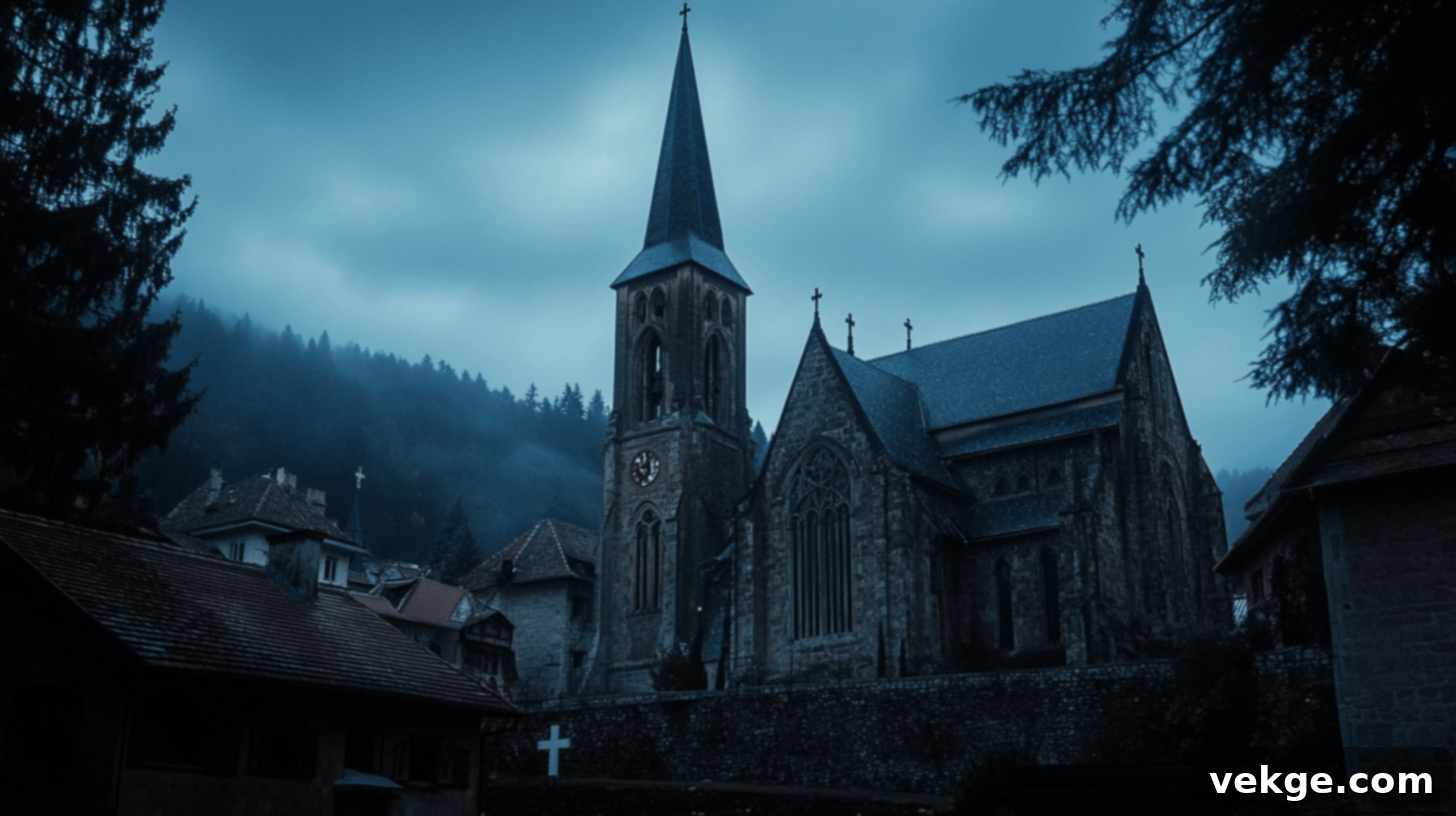
History and Importance: Located in Brașov, the Black Church (Biserica Neagră) is a magnificent Gothic church constructed between the 14th and 15th centuries, representing a cornerstone of the city’s rich cultural heritage. Its current name derives from the massive fire of 1689, which severely damaged the church and left its walls blackened by smoke. Despite this devastating event, the church stands as a testament to the resilience and architectural prowess of the Transylvanian Saxons, and it remains one of the largest and most impressive Gothic structures in the region, embodying centuries of religious history and artistic endeavor.
When to Visit: Spring and autumn offer the most pleasant weather conditions for exploring the Black Church and the charming city of Brașov. The mild temperatures make walking through the historic center and around the church a delightful experience.
Fun Facts:
- The Black Church houses one of Europe’s largest and most impressive collections of Anatolian carpets, many dating from the 17th and 18th centuries, displayed throughout its interior.
- It is home to a magnificent 4,000-pipe organ, one of the largest in Southeast Europe, which is still used for regular concerts.
- Despite its name, extensive restoration efforts have cleaned much of the smoke damage, though the “Black Church” moniker endures as a reminder of its fiery past.
8. Palace of Culture (Palatul Culturii)
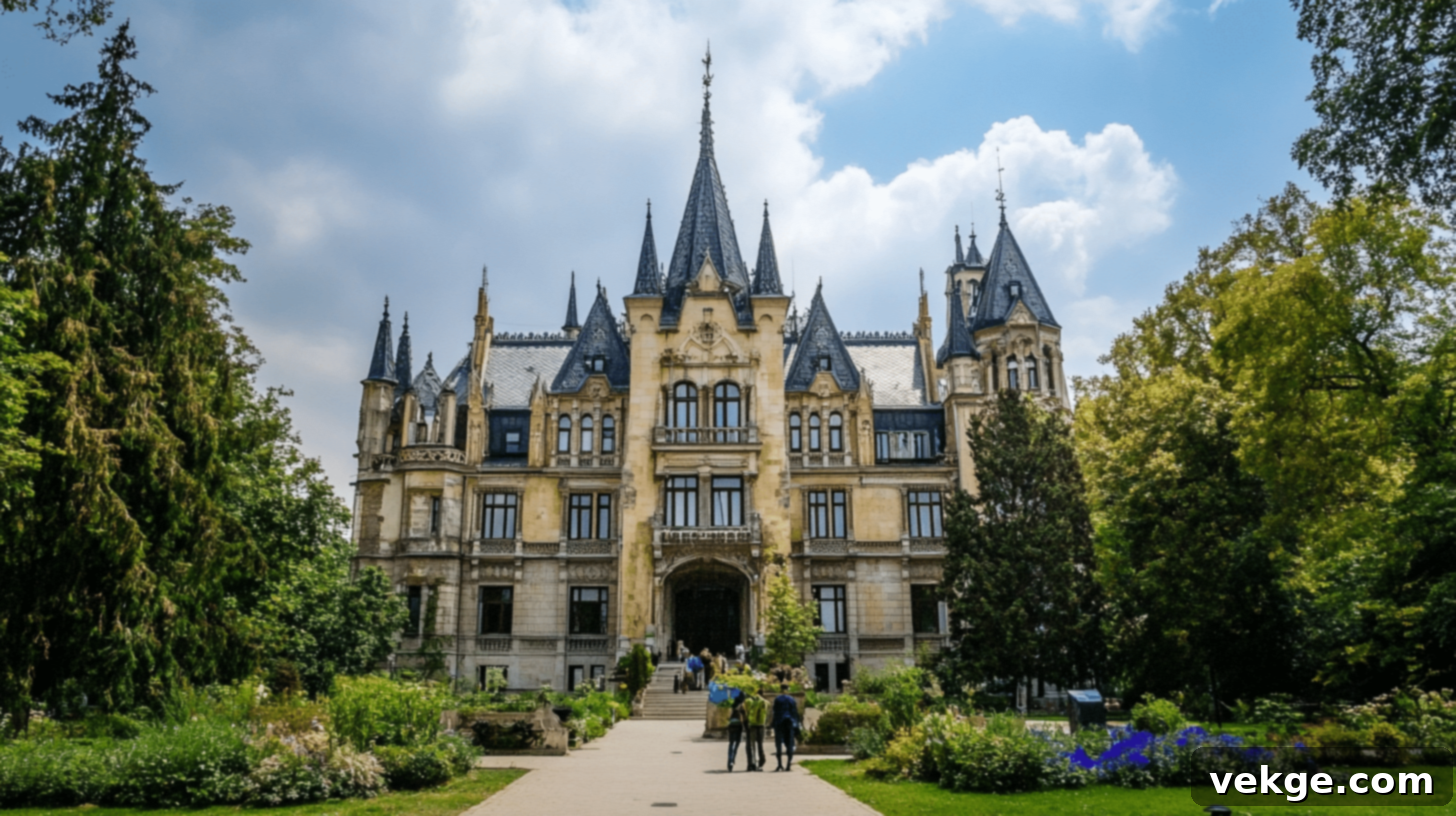
History and Importance: Situated in Iași, the Palace of Culture is an architectural marvel built between 1906 and 1925 on the hallowed ground of an old royal court. This grand Neo-Gothic masterpiece serves as a pivotal cultural center, embodying Romania’s intellectual and artistic aspirations during the early 20th century. It houses four major museums: the Museum of History of Moldavia, the Ethnographic Museum of Moldavia, the Art Museum, and the Museum of Science and Technology. The palace stands as a beacon of learning and heritage, inviting visitors to delve into the rich tapestry of Romanian history, art, and science.
When to Visit: Late spring and early autumn provide ideal conditions for exploring the Palace of Culture and the vibrant city of Iași. The pleasant weather allows for comfortable sightseeing both indoors and out, making your visit more enjoyable.
Fun Facts:
- The Palace of Culture covers an impressive area of 36,000 square meters, making it one of the largest and most expansive historical buildings in Romania.
- Within its magnificent walls, the palace contains over 300 rooms, each contributing to its grandeur and functionality as a cultural institution.
- It regularly hosts numerous cultural exhibitions, academic conferences, and special events, cementing its role as a dynamic hub for cultural exchange and education.
9. Voroneț Monastery
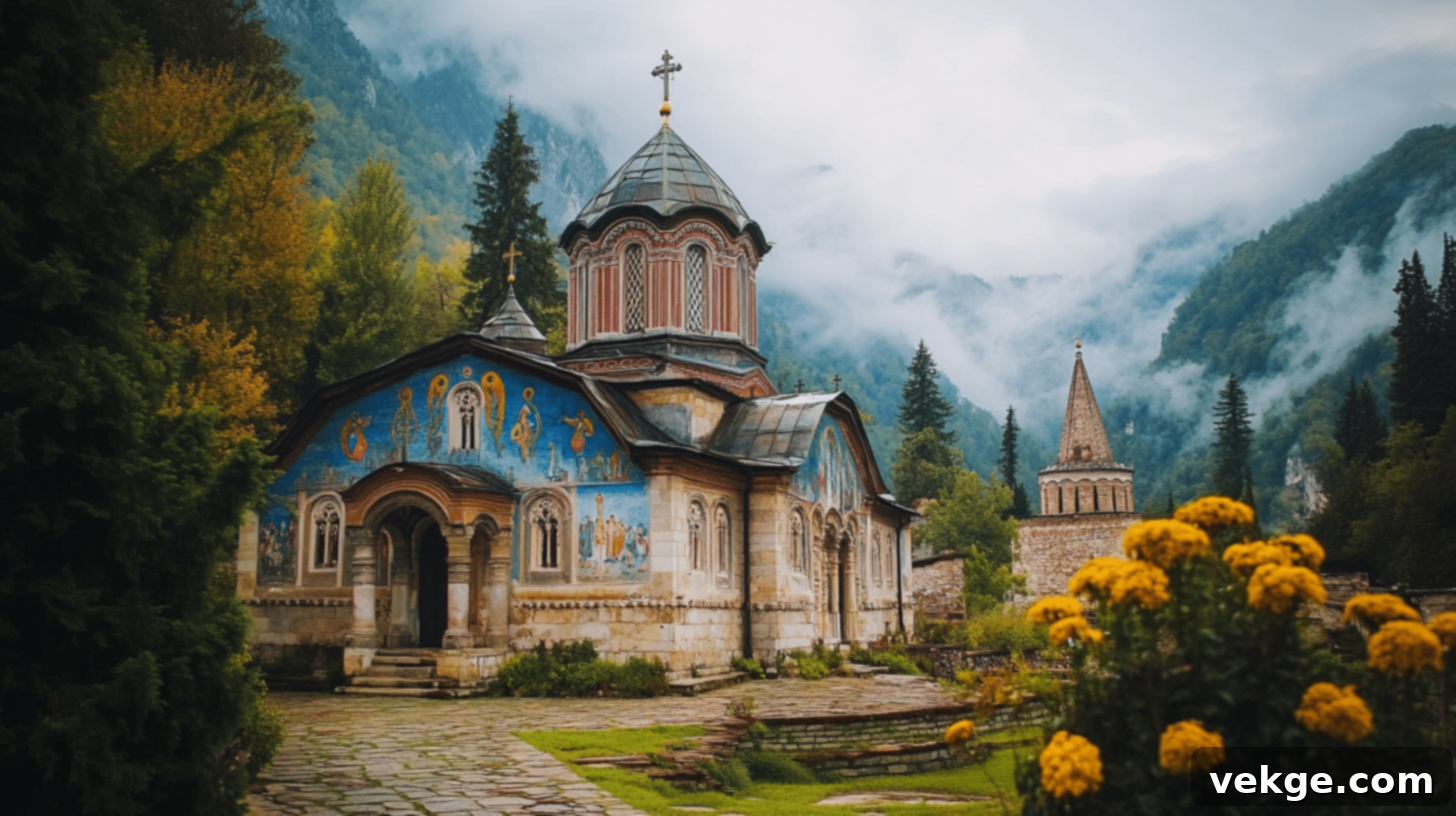
History and Importance: Founded in 1488 by Stephen the Great, the legendary Moldavian prince, Voroneț Monastery is a quintessential masterpiece of Byzantine art and a jewel among Romania’s Painted Monasteries of Bucovina. It is globally renowned for its extraordinary exterior frescoes, particularly the intense and captivating shade of blue known as “Voroneț Blue,” whose exact composition remains a mystery. This monastery represents a pinnacle of Romanian Orthodox ecclesiastical architecture and artistic expression, offering an unparalleled visual narrative of biblical scenes and theological concepts that have earned it the moniker “The Sistine Chapel of the East.”
When to Visit: The period from late spring to early autumn (May-September) is ideal. The warmer, drier weather ensures that the vibrant exterior frescoes are seen in their best light, and exploring the monastery grounds is a comfortable and enriching experience.
Fun Facts:
- Often referred to as “The Sistine Chapel of the East,” it is celebrated for its unparalleled artistry and the preservation of its vivid 15th-century frescoes.
- The monastery’s unique, vibrant blue frescoes, known as “Voroneț Blue,” have fascinated art historians for centuries due to their durability and intense pigmentation.
- Voroneț preserves complex religious artwork depicting scenes like “The Last Judgment” on its western wall, covering the entire facade and serving as a visual sermon.
10. Transfăgărășan Highway

History and Importance: Constructed between 1970 and 1974 under the orders of Nicolae Ceaușescu, the Transfăgărășan Highway is much more than a road; it’s an engineering marvel that snakes through the formidable Southern Carpathian Mountains. Initially built for military purposes to ensure rapid troop movement across the mountains, this winding road connects the historical regions of Transylvania and Wallachia, traversing challenging mountainous terrain with countless hairpin turns, viaducts, and tunnels. It stands as a powerful symbol of Romania’s ambition, technical capabilities, and the human endeavor to conquer nature, offering some of the most spectacular driving experiences in the world.
When to Visit: The highway is typically open only from mid-July to September, as it is impassable during other months due to heavy snow. This limited window offers the best conditions to experience its breathtaking vistas and thrilling curves.
Fun Facts:
- The Transfăgărășan Highway reaches altitudes over 2,000 meters (6,500 feet), providing stunning panoramic views of glacial lakes and rugged peaks.
- It was famously called “the best road in the world” by the British automotive show Top Gear, cementing its status as a must-drive route for enthusiasts.
- Its construction was extremely challenging and costly, involving significant obstacles, numerous tunnels, and hundreds of bridges built across treacherous terrain.
11. The Sphinx (Bucegi Mountains)
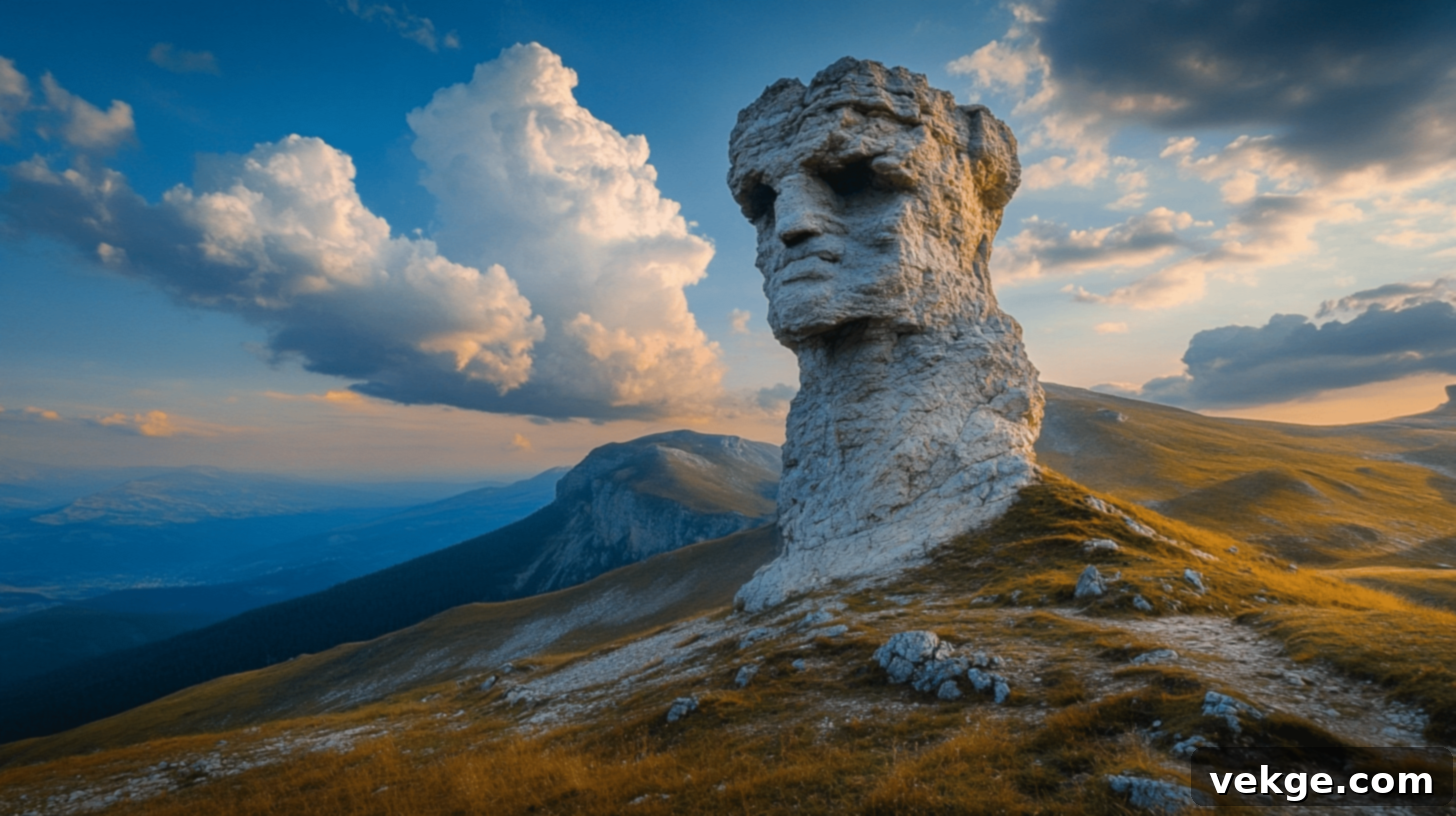
History and Importance: Perched high in the mystical Bucegi Mountains, The Sphinx is a natural rock formation that has captivated imaginations for centuries. Carved by millions of years of relentless geological processes, primarily wind and rain erosion, this remarkable stone structure strikingly resembles a human face, especially when viewed from a certain angle. Located at an altitude of 2,216 meters, The Sphinx is not just a geological wonder but also steeped in local legends and mystical beliefs, drawing both scientists and curious visitors alike. It represents a fascinating example of natural sculptural formations within the majestic Carpathian Mountains and a powerful natural landmark.
When to Visit: The best time to visit The Sphinx is during the summer months (June-September), when hiking trails are clear, and the weather is most favorable for ascending to its high altitude. Access via cable car from Bușteni is also an option.
Fun Facts:
- Its distinctive shape was meticulously sculpted over millennia by persistent wind and rain erosion, a true masterpiece of nature.
- The Sphinx is associated with numerous mystical local legends and theories, some believing it holds ancient energetic powers or hidden secrets.
- It is a popular spot for mountain photographers and hikers seeking both natural beauty and a touch of ancient mystery in the Romanian wilderness.
12. Cazanele Dunării (Danube Cauldrons)
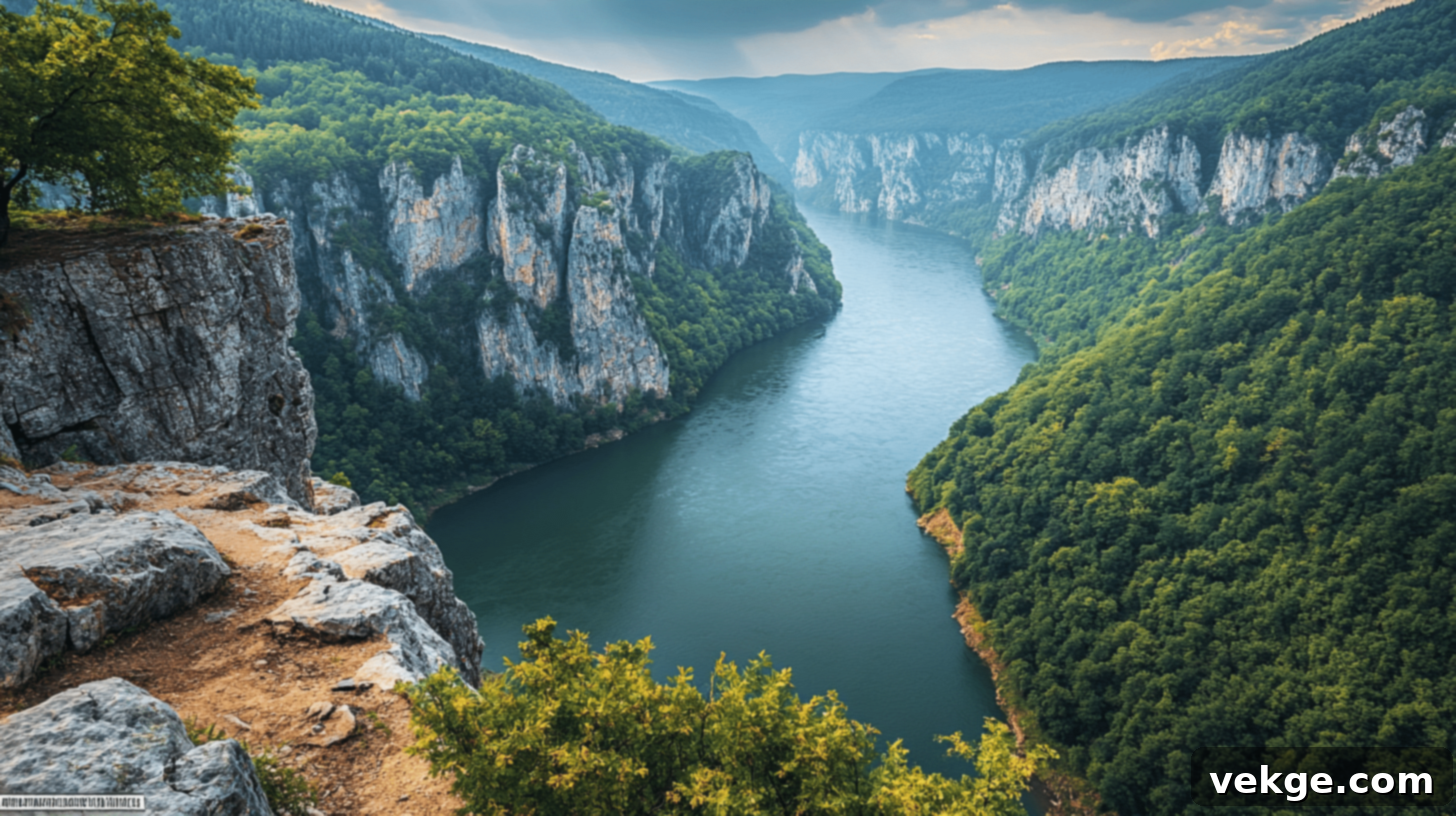
History and Importance: Cazanele Dunării, meaning “The Danube Cauldrons,” is a dramatically stunning geological formation where the mighty Danube River carves its way through the imposing Carpathian Mountains. This series of narrow gorges creates a breathtaking natural spectacle, marking a critical and picturesque point in the river’s long journey and forming part of the border between Romania and Serbia. The area boasts significant ecological importance, with unique flora and fauna thriving in its specific microclimate. It’s a natural landmark of immense beauty and a testament to the powerful forces of nature.
When to Visit: The optimal period for visiting Cazanele Dunării is from late spring to early autumn (May-October). During these months, the weather is pleasant for boat tours, which offer the best vantage points to appreciate the dramatic cliffs and the serene river.
Fun Facts:
- The area contains the famous “Decebalus Rex” rock sculpture, an enormous carving of the last king of Dacia, impressively sculpted directly into the cliff face.
- It is home to unique flora and fauna, including rare plant species and various bird species, making it a significant protected natural area.
- Considered one of Europe’s most spectacular river passages, its sheer cliffs and deep waters create an unforgettable landscape.
13. Merry Cemetery (Cimitirul Vesel)
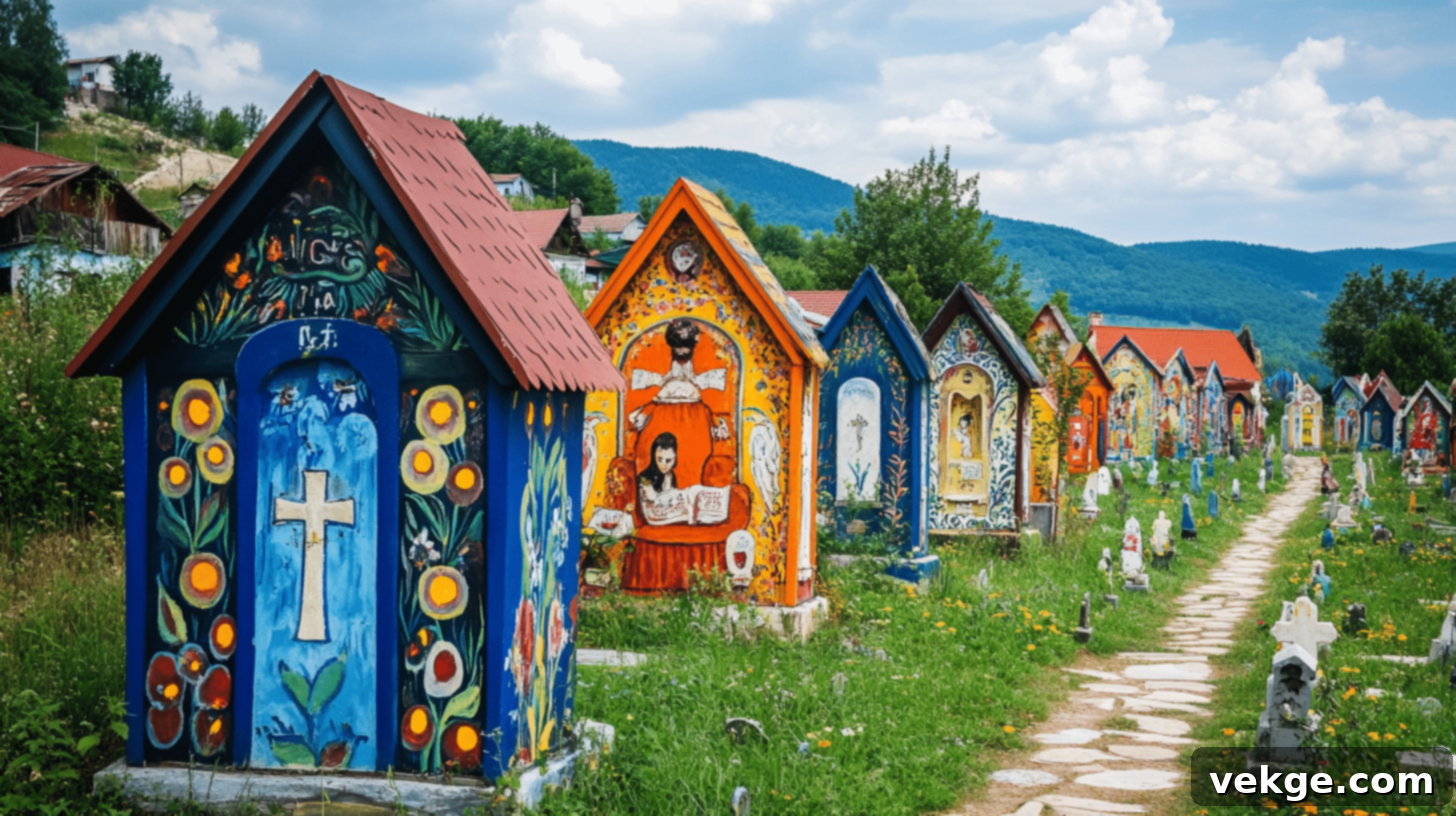
History and Importance: Located in the tranquil village of Săpânța in Maramureș, the Merry Cemetery (Cimitirul Vesel) boldly transforms the traditional concept of mourning into a vibrant celebration of life. Conceived and initiated by local artist Stan Ioan Pătraș in 1935, each tombstone is a unique work of art, featuring brightly colored paintings depicting scenes from the deceased’s life, accompanied by humorous, often poetic, epitaphs. This extraordinary cemetery represents a distinctive Romanian cultural approach to death and remembrance, rooted in ancient Dacian beliefs that death is not a tragedy but a passage to another life. It’s a poignant and joyful landmark, unlike any other in the world.
When to Visit: The summer months (June-August) are ideal for visiting, as the weather is warm and the colors of the tombstones are particularly vivid under the sunlight. This also allows for comfortable exploration of the open-air site.
Fun Facts:
- The cemetery boasts over 800 colorful tombstones, each a hand-carved, hand-painted wooden cross adorned with distinctive folk art.
- Every epitaph, written in first-person, tells a short, often witty or critical, story about the deceased’s life, habits, or cause of death, reflecting local village life.
- It is a unique cultural heritage site that offers a profound insight into Romanian folklore, spirituality, and the acceptance of life’s natural cycle.
14. Scărișoara Cave

History and Importance: Hidden deep within the stunning Apuseni Mountains, Scărișoara Cave is a remarkable natural wonder that harbors the largest underground glacier in Romania, and one of the oldest and largest in the world. Discovered in 1863, this magnificent ice cave maintains a constant temperature below freezing throughout the year, preserving an ancient ice formation that has been in place for millennia. Scientific studies conducted here have revealed invaluable insights into geological and climatic history, making it a crucial site for glaciology and paleoclimatology. Its ethereal beauty, with colossal ice stalagmites and stalactites, is simply breathtaking.
When to Visit: It is best to visit during the summer months (June-September). While the cave maintains its cold temperature year-round, accessing it during winter can be extremely challenging and potentially dangerous due to heavy snow and ice on mountain roads.
Fun Facts:
- The impressive ice formation within the cave dates back an astonishing 3,500 years, offering a frozen window into ancient climatic conditions.
- The cave’s main chamber, known as “The Great Hall,” is home to a massive ice block that is over 20 meters deep, maintaining temperatures consistently below 0°C.
- Scărișoara Cave serves as an important research site for glaciology and climate change studies, providing unique data from its well-preserved ice.
15. Bigăr Waterfall
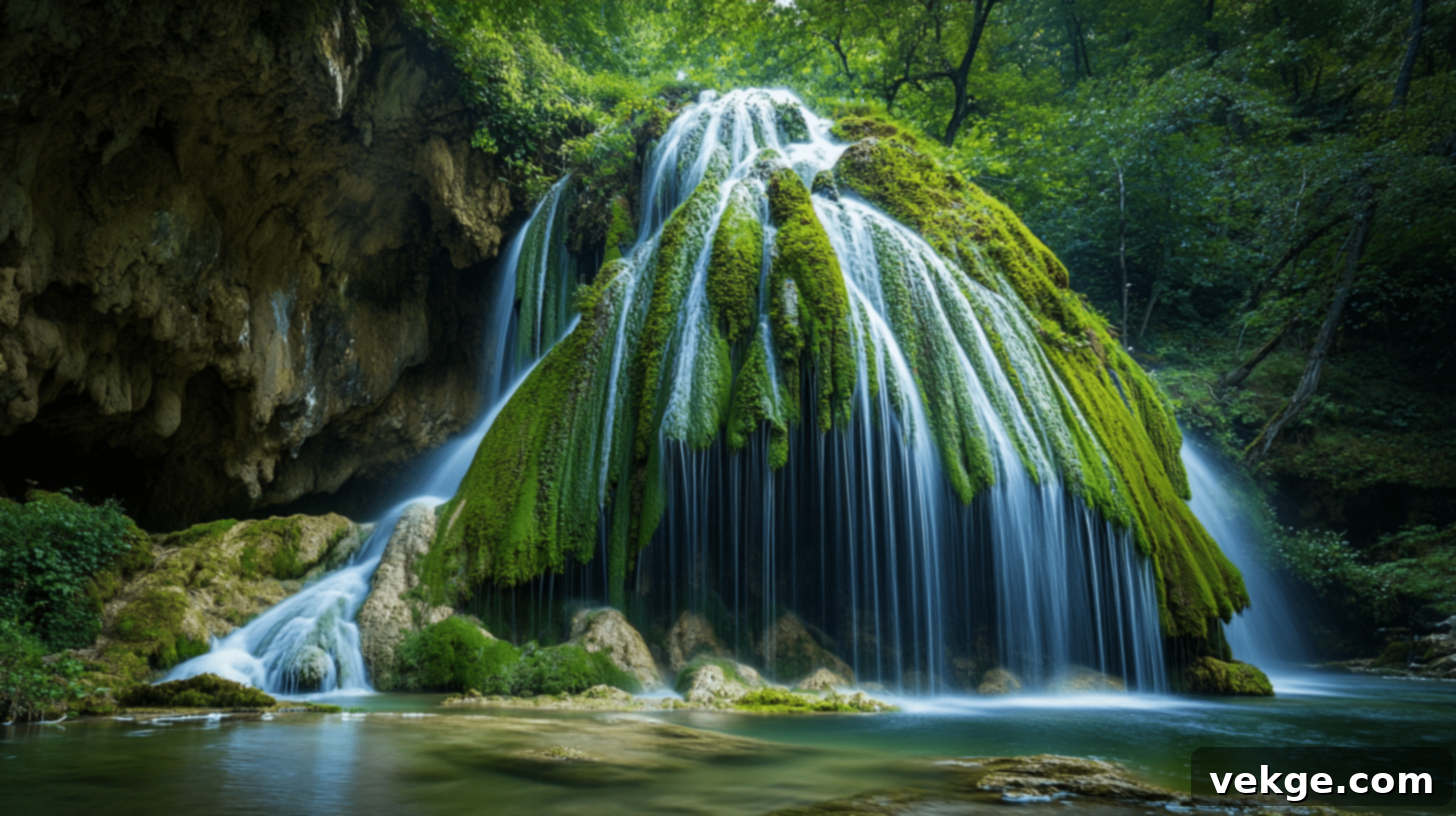
History and Importance: Located in the picturesque Caraș-Severin County, Bigăr Waterfall is a natural phenomenon renowned for its extraordinary beauty and unique geological formation. Unlike conventional waterfalls, the water gently cascades over a vibrant, moss-covered, bell-shaped rock, creating a mesmerizing natural spectacle that appears almost otherworldly. This delicate marvel represents the profound and intricate beauty of Romania’s natural landscapes, showcasing how water, rock, and vegetation can conspire to form something truly magical. It’s a peaceful and enchanting landmark that inspires awe and a deep appreciation for nature.
When to Visit: The period from late spring to early autumn (May-September) is ideal for visiting Bigăr Waterfall. During these months, the surrounding vegetation is lush, and the moss on the rock is at its most vibrant green, enhancing the waterfall’s ethereal beauty.
Fun Facts:
- Bigăr Waterfall was once named by The World Geography as one of the most beautiful waterfalls globally, a testament to its unique visual appeal.
- It is located within the Cheile Nerei-Beușnița National Park, a protected natural area that safeguards its unique ecosystem and surrounding biodiversity.
- The waterfall’s unique geological formation, with water flowing over a dome of travertine covered in moss, is incredibly rare and contributes to its distinctive charm.
16. Constanța Casino
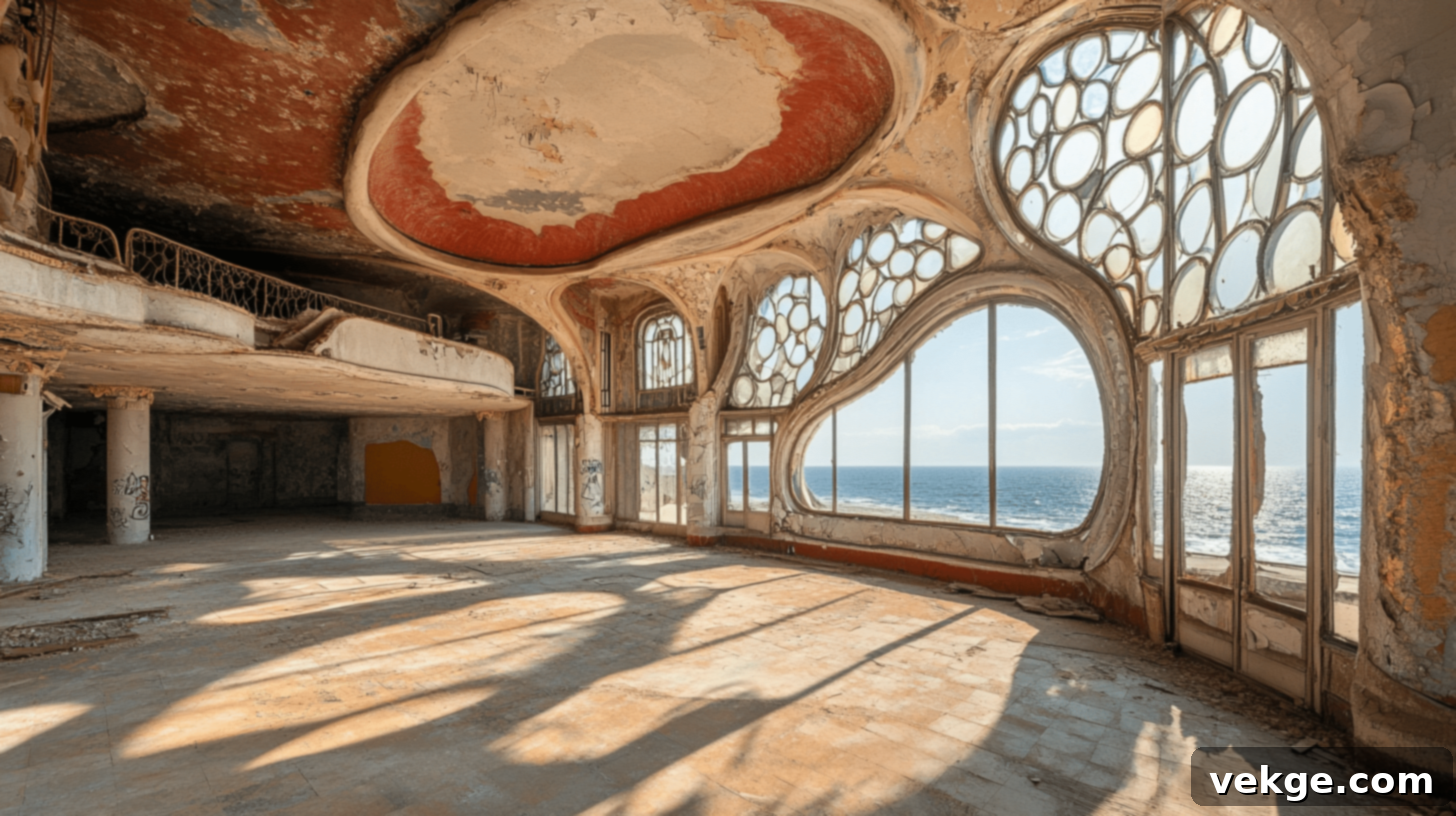
History and Importance: Erected in 1910, the Constanța Casino stands as a remarkable Art Nouveau architectural marvel gracefully overlooking the Black Sea coast. Designed by Romanian and Swiss architects, it quickly became a symbol of the city’s golden age of prosperity and glamour, attracting European high society. Once a glamorous social hub for the elite, the building, though currently undergoing extensive restoration, profoundly reflects Romania’s early 20th-century cultural aspirations, architectural innovation, and its connection to European elegance. It remains a poignant reminder of a bygone era and a landmark of Romanian maritime architecture.
When to Visit: Late spring to early autumn (May-September) is the best time to visit Constanța. The warmer weather allows for comfortable exploration of the city and its seaside attractions, including admiring the casino’s exterior and observing its ongoing restoration efforts.
Fun Facts:
- The casino was primarily designed by Romanian architect Daniel Renard, who envisioned its stunning Art Nouveau style with distinct curvilinear forms and ornate decorations.
- It has survived multiple historical periods, including two World Wars and the communist era, bearing witness to over a century of Romanian history.
- Considered the most iconic landmark of Constanța and a jewel of Romanian maritime architecture, it continues to inspire awe despite its current state.
17. Sarmizegetusa Regia
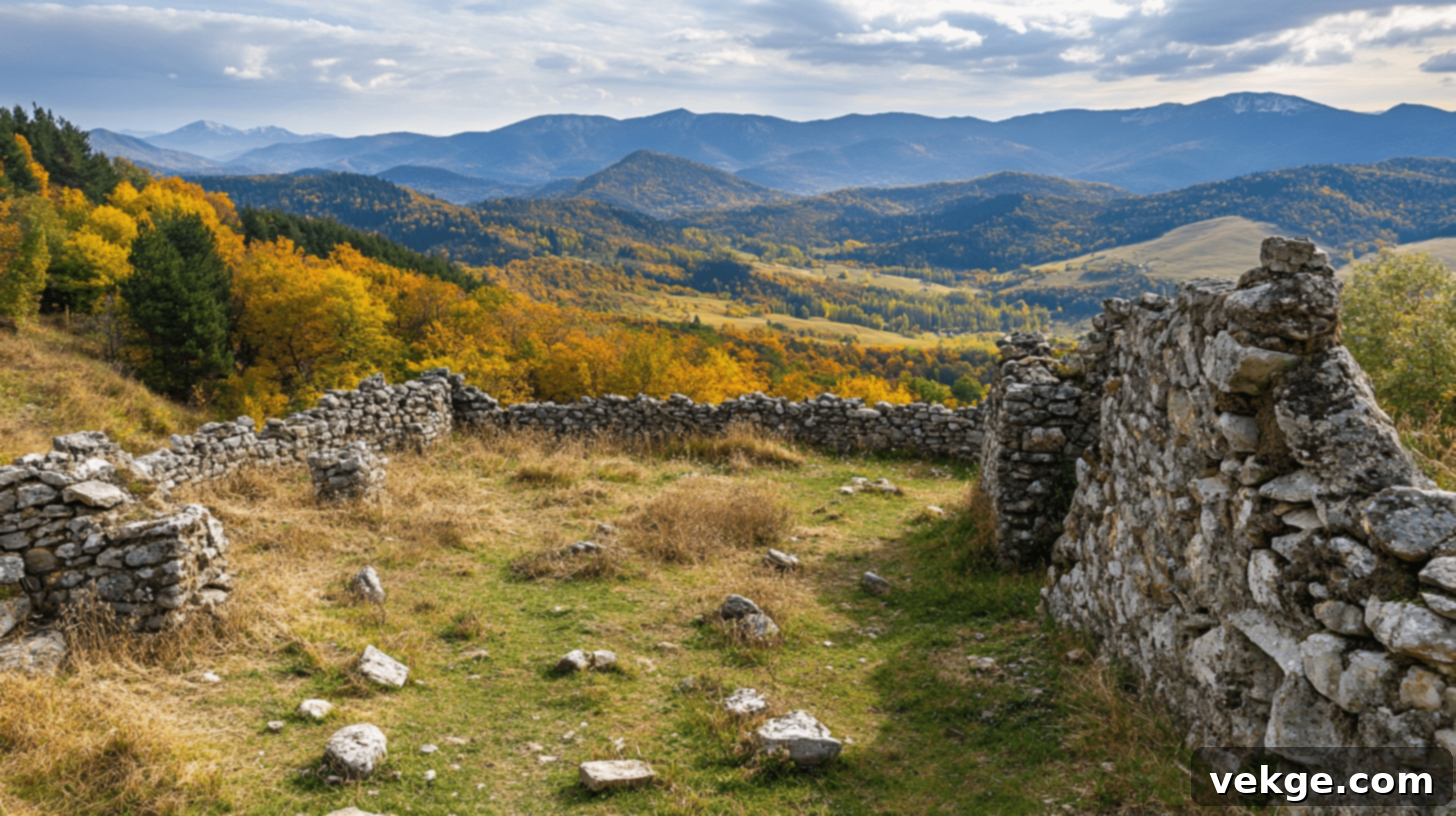
History and Importance: Hidden deep within the Orăștie Mountains, Sarmizegetusa Regia was the formidable ancient capital of the Dacian Kingdom and represents the core of pre-Roman civilization in Romania. This archaeological site, dating back to the 1st century BC, served as a crucial political, religious, and military center for the Dacian people before their conquest by the Roman Empire. The remnants of its complex architectural structures, including unique circular stone sanctuaries and defensive walls, reveal a sophisticated ancient engineering and cultural prowess. As a UNESCO World Heritage Site, it offers a profound journey into the origins of the Romanian nation.
When to Visit: The period from late spring to early autumn (May-September) provides the most favorable conditions for exploring Sarmizegetusa Regia. The mild weather makes hiking through the forested archaeological site comfortable and enjoyable.
Fun Facts:
- As a UNESCO World Heritage Site, it is recognized globally for its outstanding historical and archaeological significance.
- The site contains unique circular stone sanctuaries, resembling astronomical observatories, which hint at the advanced knowledge and spiritual practices of the Dacians.
- The impressive defensive walls and intricate stone structures demonstrate advanced ancient engineering techniques used by the Dacian civilization.
18. Biertan Church

History and Importance: Perched majestically on a hill overlooking the picturesque village of Biertan in Transylvania, this 16th-century fortified Lutheran church stands as a remarkable testament to Saxon architectural and religious heritage. Recognized as a UNESCO World Heritage Site, it is a prime example of the defensive church structures typical of medieval Transylvanian settlements, built not only for worship but also for protection against invaders. Its imposing walls, multiple defensive layers, and intricate interior showcase remarkable architectural and cultural significance, offering a unique glimpse into the lives of the Saxon communities that thrived here for centuries.
When to Visit: The summer months (June-August) are ideal for visiting Biertan Church. The pleasant weather allows for comfortable exploration of the church complex and the charming surrounding village, often enhanced by local cultural events.
Fun Facts:
- The church features a unique lock system on its main sacristy door, which has 19 different locking mechanisms, making it an engineering marvel of its time and highly secure.
- Inside, visitors can admire intricate wood craftsmanship, including a beautifully carved altar and ornate wooden pews, showcasing the artistic skills of the Saxon community.
- Beyond its religious function, the church served as a vital defensive structure, providing refuge for villagers during times of conflict and maintaining a store of provisions within its walls.
19. Danube Delta
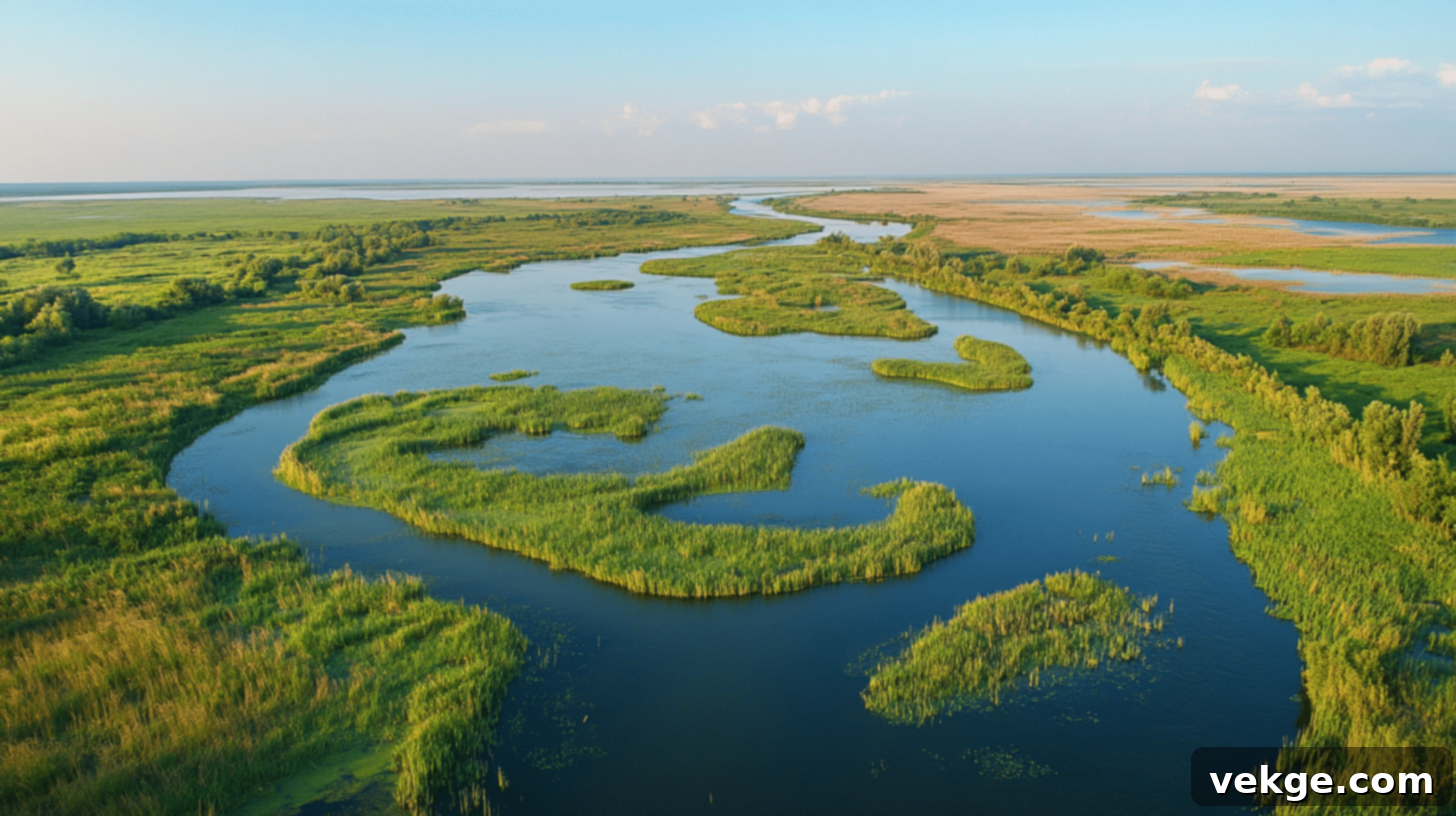
History and Importance: The Danube Delta, a designated UNESCO World Heritage Site and Biosphere Reserve, represents one of Europe’s most extensive and complex ecological systems. Formed over thousands of years where the mighty Danube River meets the Black Sea, this unique wetland landscape is a labyrinth of canals, lakes, reed beds, and floating islands. It hosts extraordinary biodiversity, serving as a critical habitat for an unparalleled number of plant and animal species, including one of the world’s largest colonies of pelicans. This pristine natural wonder is a living testament to environmental richness and a paradise for nature lovers and birdwatchers.
When to Visit: Spring and early summer (April-June) are the best times to experience the Danube Delta. During these months, the delta bursts with life, with migratory birds returning, lush vegetation, and mild temperatures perfect for boat trips and wildlife viewing.
Fun Facts:
- The Danube Delta is home to over 300 bird species, making it a premier birdwatching destination and a crucial stop for migratory birds between Europe, Asia, and Africa.
- It covers an immense area of approximately 5,800 square kilometers, making it the second-largest river delta in Europe.
- Recognized as a Biosphere Reserve, the delta is a critical area for ecological research, conservation, and sustainable tourism, highlighting its global importance.
20. The Endless Column (Coloana Infinitului)
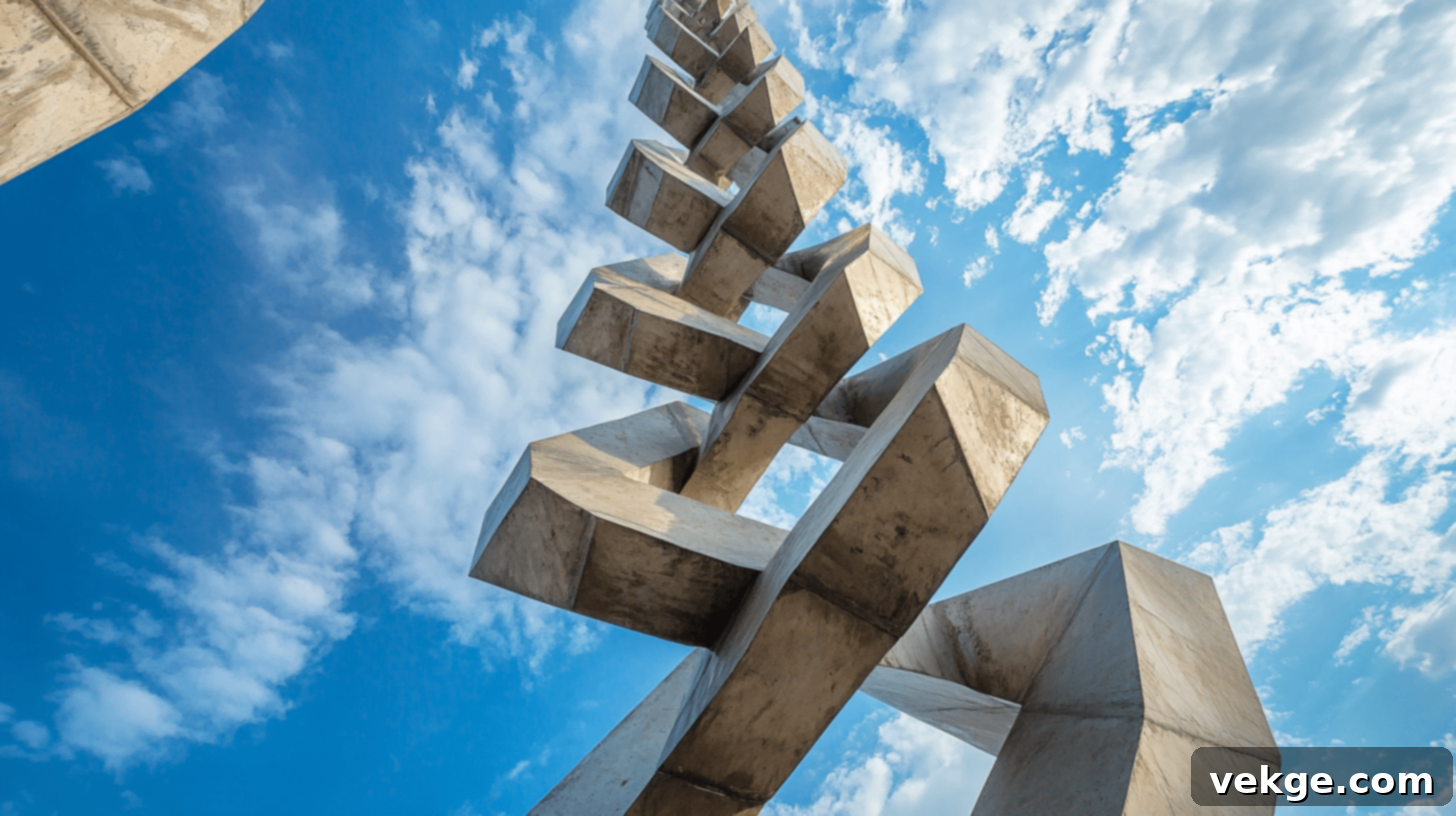
History and Importance: Standing tall in Târgu Jiu, The Endless Column (Coloana Infinitului) is one of the most iconic works by the renowned Romanian sculptor Constantin Brâncuși, created in 1938. This profound monument is part of a larger memorial complex honoring Romanian soldiers who valiantly defended the city during World War I. Composed of modular rhomboidal cast iron units stacked atop one another, it symbolizes infinite sacrifice, rising perpetually towards the sky. The column represents a fundamental work of modern sculpture, embodying philosophical concepts of eternity, infinity, and remembrance, inviting deep contemplation on heroism and human spirit.
When to Visit: The Endless Column is accessible year-round. Its outdoor location allows visitors to experience its imposing presence and the interplay of light and shadow on its metallic segments regardless of the season, though pleasant weather in spring or autumn might enhance the visit.
Fun Facts:
- The column is made of 16 modular cast-iron segments, resembling stacked beads, which give it its distinctive repetitive and upward-stretching form.
- It is part of a larger memorial ensemble in Târgu Jiu, which also includes the “Table of Silence” and the “Gate of the Kiss,” all designed by Brâncuși to honor the fallen soldiers.
- Considered a masterpiece of modern sculpture and a pivotal work in Brâncuși’s oeuvre, it continues to inspire artists and visitors worldwide.
21. Mud Volcanoes (Berca)
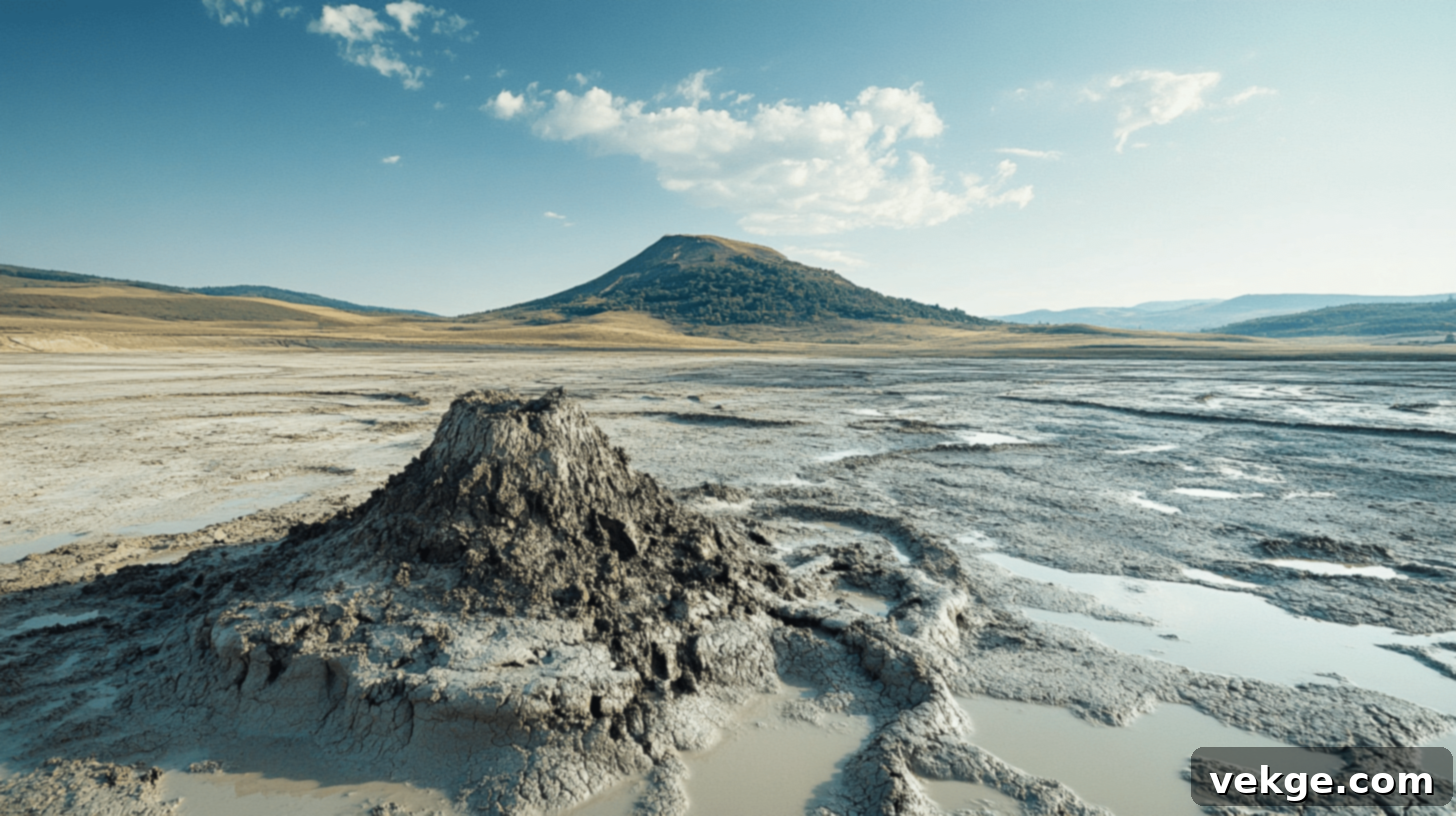
History and Importance: In the surreal landscape of Buzău County, the Mud Volcanoes of Berca present a unique geological phenomenon. Here, natural gas and mud erupt from underground, creating small, cone-shaped structures that resemble miniature volcanoes. Formed by geological processes where deep-seated gases push underground clay and water deposits to the surface, this site creates an otherworldly, lunar-like terrain that is both scientifically fascinating and visually captivating. These bubbling formations attract geologists, photographers, and curious travelers from around the globe, standing as a testament to the powerful, unseen forces at work beneath the Earth’s surface. It’s a truly distinctive natural landmark.
When to Visit: Late spring to early autumn (May-September) is the most suitable period for visiting the Mud Volcanoes. During these months, the weather is dry and pleasant, making exploration of the uneven, muddy terrain more comfortable and enjoyable.
Fun Facts:
- The Mud Volcanoes cover approximately 30 hectares, creating an expansive and bizarre landscape that feels like another planet.
- This unique geological formation represents the lowest altitude volcanic landscape in Europe, making it an exceptional site for scientific study.
- The area is a protected natural reserve, safeguarding its unique geological features and the specialized flora that adapts to its saline and often arid soil conditions.
22. Coral Temple (Templul Coral)
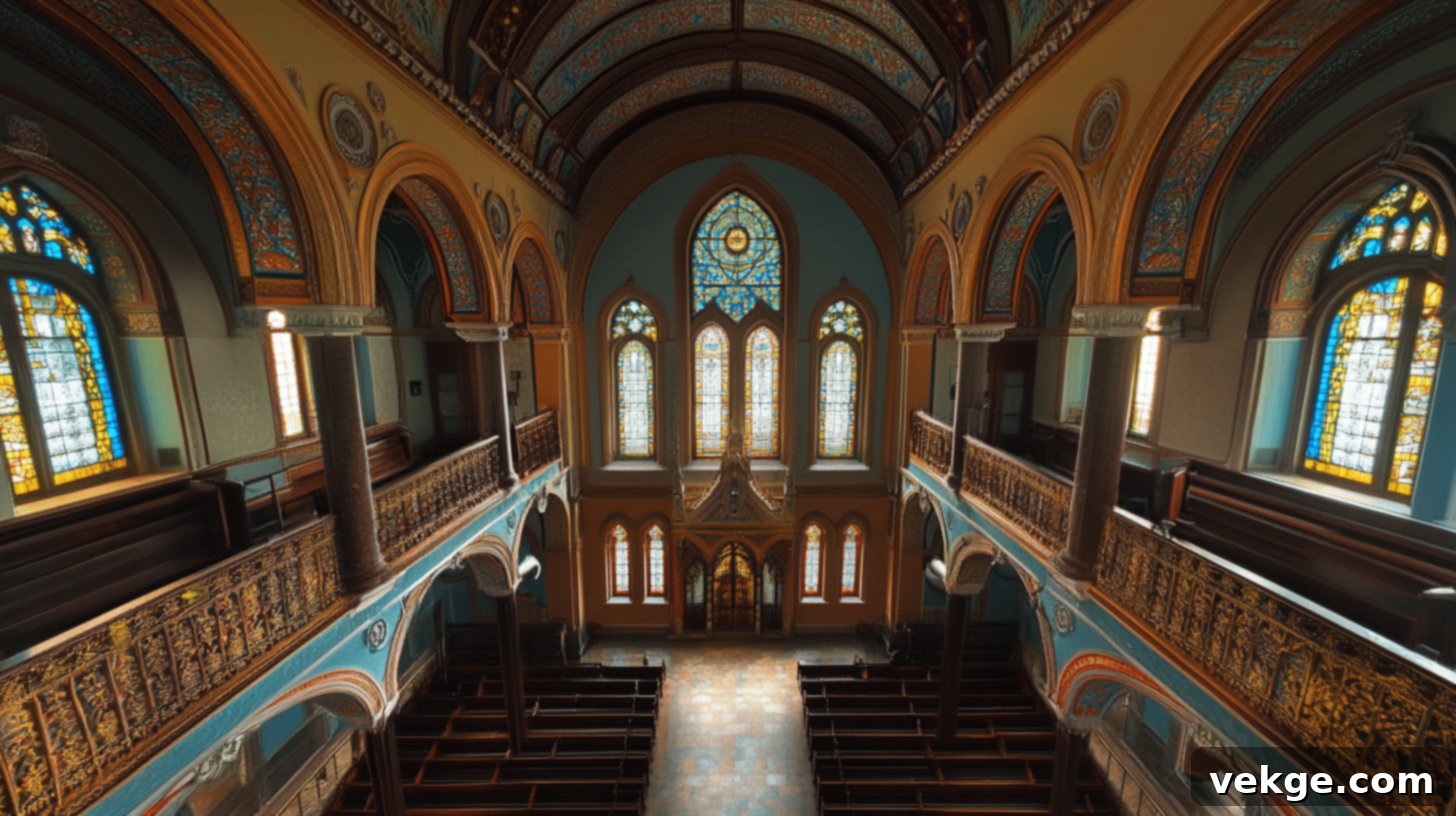
History and Importance: The Coral Temple (Templul Coral) is a significant Jewish synagogue in Bucharest, a vibrant testament to the cultural and religious heritage of Romania’s Jewish community. Constructed in 1857 and consecrated in 1867, this architecturally stunning synagogue, designed in the exquisite Moorish-Byzantine style, is located in the city’s historic center. It has remarkably survived multiple historical challenges, including the devastating Bucharest earthquake of 1977 and the tumultuous periods of World War II and the communist regime. Today, it serves as a critical symbol of religious tolerance and cultural diversity in Romania’s capital, standing as an active place of worship and a guardian of Jewish history.
When to Visit: Spring and autumn (April-June, September-October) offer comfortable temperatures for exploring Bucharest and visiting the Coral Temple. It’s advisable to check visiting hours or guided tour availability, as it is an active synagogue.
Fun Facts:
- The temple’s design is a stunning example of Moorish-Byzantine style, characterized by its intricate geometric patterns, horseshoe arches, and vibrant interior decorations.
- It remarkably survived the atrocities of World War II, when many synagogues were destroyed, thanks to the courage of local individuals who protected it.
- The Coral Temple houses important religious artifacts, historical documents, and a museum section that narrates the rich history of the Jewish community in Romania.
23. Scaunul Domnesc (Prince’s Throne)

History and Importance: Located within the impressive Suceava Fortress complex, Scaunul Domnesc, or “Prince’s Throne,” is a historically significant site representing the administrative and political heart of medieval Moldavia. This area served as the official seat of governance for Moldavian princes, most notably Stephen the Great, during the 14th to 16th centuries. It symbolizes the immense political power and strategic importance of the region during a period of great challenges and achievements. A visit to Scaunul Domnesc connects visitors directly to the rich governmental history of Romanian principalities, allowing a tangible experience of the region’s royal heritage and enduring legacy.
When to Visit: The period from late spring to early autumn (May-September) offers the most pleasant weather conditions for exploring the outdoor archaeological site of Scaunul Domnesc and the broader Suceava Fortress complex.
Fun Facts:
- Scaunul Domnesc is an integral part of the vast and historically rich Suceava Fortress complex, which served as the main residence of the Moldavian princes.
- The site is intimately connected to important historical rulers, particularly Stephen the Great, who expanded and fortified the complex during his reign.
- It represents a significant archaeological site, with ongoing excavations continuing to uncover more about the medieval Moldavian court and its daily life.
24. Piața Unirii (Union Square)
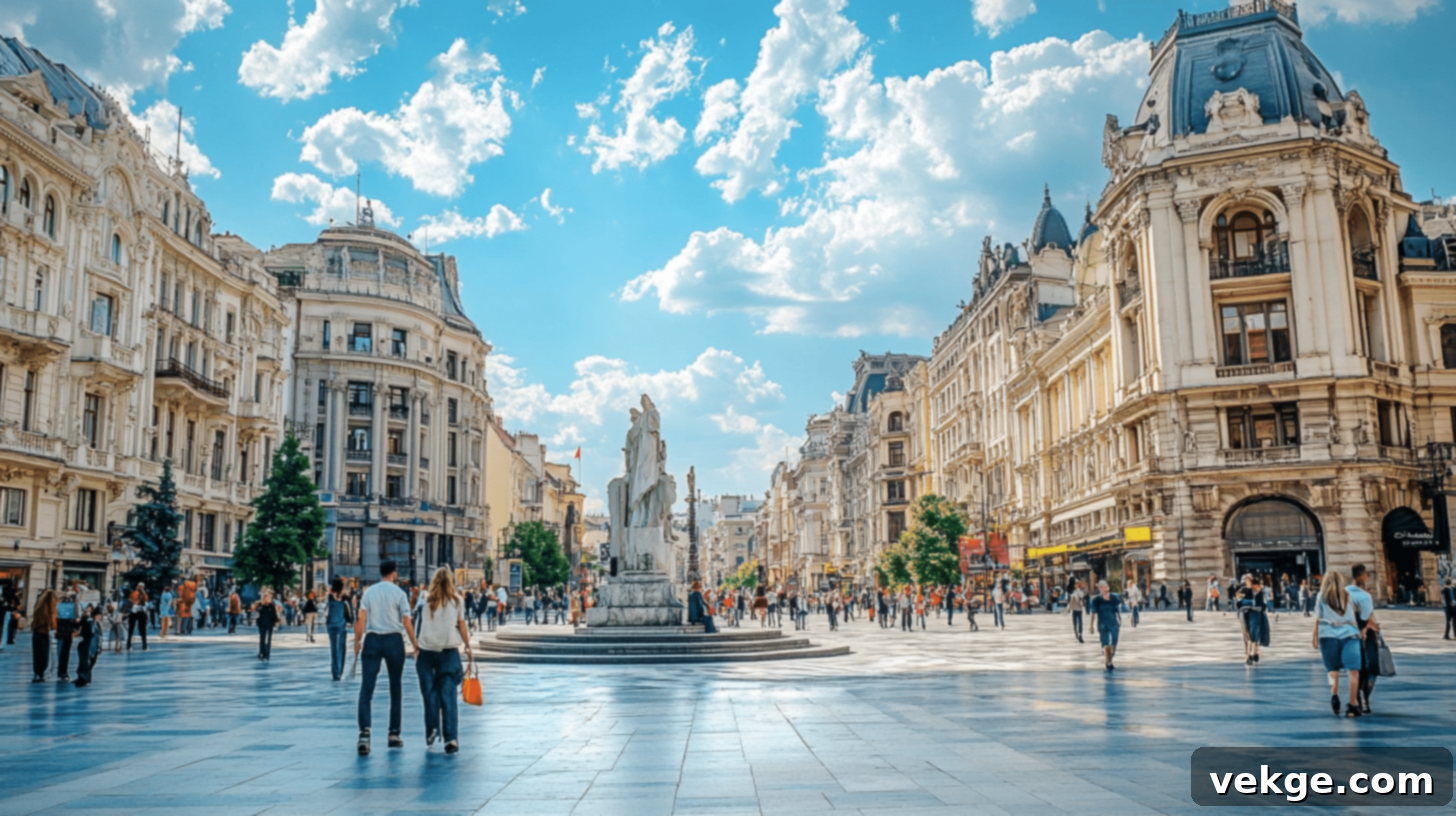
History and Importance: Piața Unirii, or Union Square, is a bustling and historically rich central square in Bucharest, serving as a vital artery of the city’s civic and cultural life. Surrounded by a blend of significant historical buildings, including the iconic University of Bucharest, the square has been a silent witness to countless pivotal political and social events throughout Romania’s modern history. From public demonstrations to celebrations, it has always been a critical gathering point for the city’s inhabitants. Today, with its fountains, green spaces, and surrounding commercial areas, it remains a vibrant hub that reflects the dynamic pulse of the Romanian capital.
When to Visit: Piața Unirii offers year-round accessibility and charm. While spring and autumn provide the most comfortable weather for leisurely strolls, the square takes on a special festive atmosphere during holidays, particularly in winter when adorned with lights.
Fun Facts:
- It serves as one of the central points of Bucharest, from which many major boulevards radiate, making it a crucial navigational and historical landmark.
- The square is surrounded by significant historical buildings, modern shopping centers, and vibrant urban spaces that illustrate Bucharest’s architectural evolution.
- Piața Unirii frequently hosts various cultural events, markets, and public gatherings, reinforcing its role as a living heart of the city.
25. Dimitrie Gusti National Village Museum
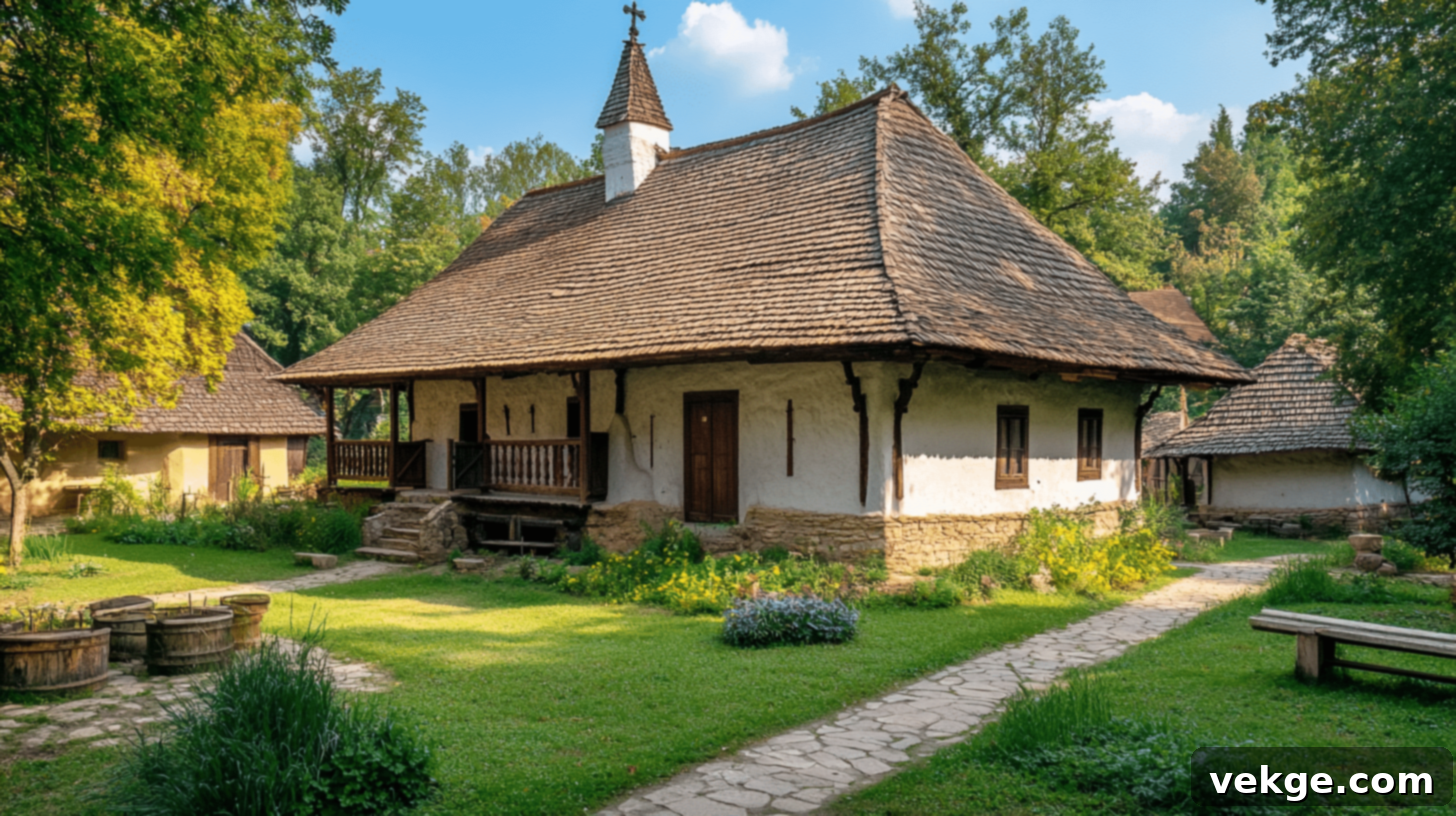
History and Importance: Established in 1936, the Dimitrie Gusti National Village Museum in Bucharest is an exceptional open-air museum that meticulously preserves and showcases traditional Romanian rural architecture and the authentic way of life from various regions of the country. Named after the distinguished sociologist Dimitrie Gusti, this innovative museum features over 300 authentic houses, churches, and farm buildings, painstakingly relocated and reconstructed to depict different historical periods and architectural styles. It is a living testament to Romania’s rich cultural heritage, providing an immersive experience into the ingenuity, traditions, and resilience of its rural communities.
When to Visit: The period from spring to autumn (April-October) is ideal for visiting, as the museum is outdoors. During these months, the weather is pleasant for walking, and the lush surroundings enhance the experience of exploring the traditional village settings.
Fun Facts:
- The museum spans an impressive 10 hectares along the shore of Lake Herăstrău, offering a sprawling and immersive experience of rural Romania.
- It contains over 300 authentic traditional buildings, including houses, churches, and windmills, each carefully moved from its original location and reassembled.
- The collection represents multiple Romanian regions, allowing visitors to appreciate the diverse architectural styles, craftsmanship, and customs that define the nation’s rural tapestry.
26. Cărturești Carusel

History and Importance: Cărturești Carusel is not merely a bookstore; it’s a breathtaking cultural space housed within a magnificently restored 19th-century building in Bucharest’s historic Old Town. Once a bank and later a dilapidated property, it was meticulously transformed from a historic residence into a stunning six-level bookstore, café, and art gallery. This architectural revival represents a remarkable dedication to preserving cultural heritage while creating a vibrant modern space. The interior skillfully blends historical architectural elements with sleek, contemporary design, resulting in a unique literary and cultural environment that is as much an attraction as its extensive collection of books.
When to Visit: Cărturești Carusel is a wonderful destination year-round. Its indoor setting provides a cozy retreat regardless of the weather, making it perfect for a leisurely browse, a coffee break, or attending one of its many cultural events.
Fun Facts:
- This enchanting bookstore is spread across six levels, offering a vast array of books, music, films, and design objects, all within a stunning visual setting.
- The building’s restoration beautifully combines its original historical architecture, such as elegant columns and intricate ironwork, with modern, minimalist design elements.
- Cărturești Carusel houses an extensive book collection in both Romanian and English, along with a top-floor bistro offering panoramic views of the city.
27. The Romanian Academy (Academia Română)
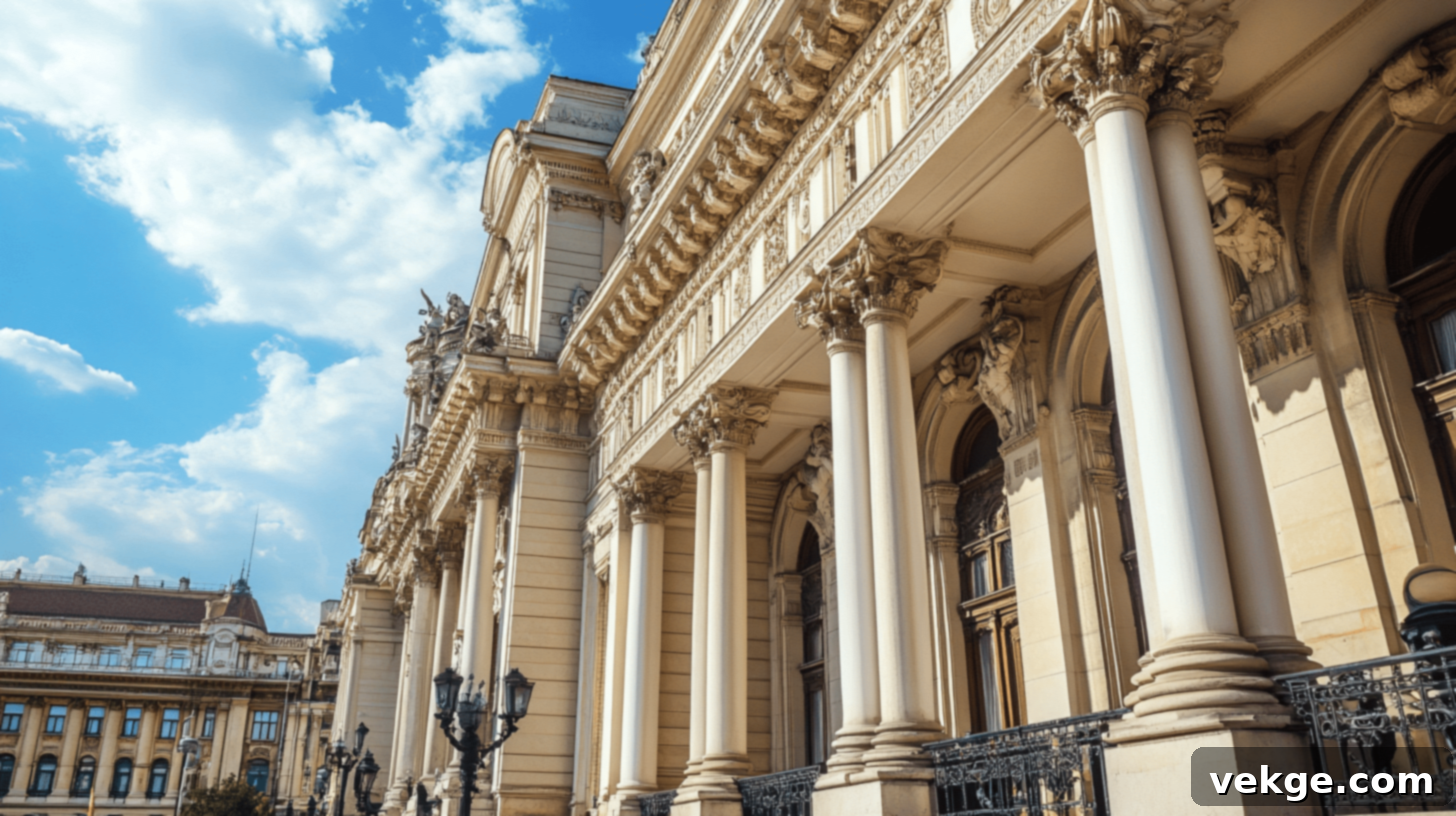
History and Importance: Founded in 1866, The Romanian Academy (Academia Română) stands as the pinnacle of Romanian scientific and cultural research, a prestigious institution dedicated to preserving and promoting the nation’s intellectual heritage. Housed in a magnificent Neo-classical building in Bucharest, it serves as a critical center for advanced scientific research, literary preservation, and academic excellence across various fields. The academy has played an indispensable role in shaping Romanian intellectual life for generations, contributing significantly to the development of the Romanian language, science, literature, and arts. It is a symbol of national scholarly pride and an enduring landmark of intellectual pursuit.
When to Visit: Public access to The Romanian Academy is typically limited to special events or guided tours by prior arrangement. While the exterior can be admired year-round, interested visitors should inquire about specific visiting opportunities to fully appreciate its interior and historical significance.
Fun Facts:
- The Romanian Academy houses an extensive historical library, one of the largest and most important in Romania, containing invaluable manuscripts, rare books, and historical documents.
- It is a significant research institution, with numerous institutes and centers dedicated to advancing knowledge in fields ranging from linguistics and history to mathematics and engineering.
- The academy hosts important cultural collections and archives, acting as a custodian of Romania’s intellectual and artistic legacy for future generations.
Conclusion: Your Unforgettable Romanian Adventure Awaits
As you’ve journeyed through this guide to Romania’s extraordinary landmarks, it becomes clear that this Eastern European nation is far more than just a travel destination—it is a profound experience that will linger in your memory long after your return. Each site, from the ancient fortifications of Transylvania to the natural wonders of the Carpathians and the Danube Delta, tells a unique story of resilience, creativity, and unparalleled cultural richness.
Romania offers a diverse tapestry of experiences, whether you are a history enthusiast eager to walk in the footsteps of kings and legends, a nature lover yearning for breathtaking landscapes, or a curious traveler seeking authentic cultural encounters. The blend of medieval charm, communist-era grandeur, vibrant folk traditions, and untouched wilderness creates an adventure like no other.
Plan your Romanian adventure today and allow yourself to be captivated by centuries of human spirit and natural wonder. These landmarks are not just points on a map; they are gateways to understanding a nation defined by its vibrant past and promising future. Get ready for an unforgettable journey that connects you deeply to the heart and soul of Romania.
For more inspiring travel insights and detailed guides, please explore other blogs on our website!
Frequently Asked Questions About Traveling in Romania
What is Romania famous for?
Romania is celebrated for its dramatic Carpathian Mountains, particularly the scenic Transfăgărășan Highway; its legendary medieval castles such as Bran Castle (often linked to Dracula) and Peleș Castle; its rich tradition of winemaking; delicious traditional cuisine like sarmale (stuffed cabbage rolls); the iconic Dacia cars; the beautiful Black Sea coast; endless fields of sunflowers; the unique painted monasteries of Bucovina; and the ecologically diverse Danube Delta, one of Europe’s largest wetlands.
Romania is rich in what resources?
Romania possesses a wealth of natural and economic resources. It boasts vast and fertile agricultural lands, a diverse array of energy sources including oil, natural gas, hydropower, and emerging renewable energies. The country also has an established manufacturing base, particularly in the automotive and textile sectors, and a rapidly expanding tourism industry, especially along the Black Sea coast, in its mountain resorts, and at its numerous historical and cultural sites.
What is the currency of Romania called?
The official currency of Romania is the Romanian Leu (plural: Lei), abbreviated as RON. While Romania is a member of the European Union, it has not yet adopted the Euro and continues to use its national currency.
